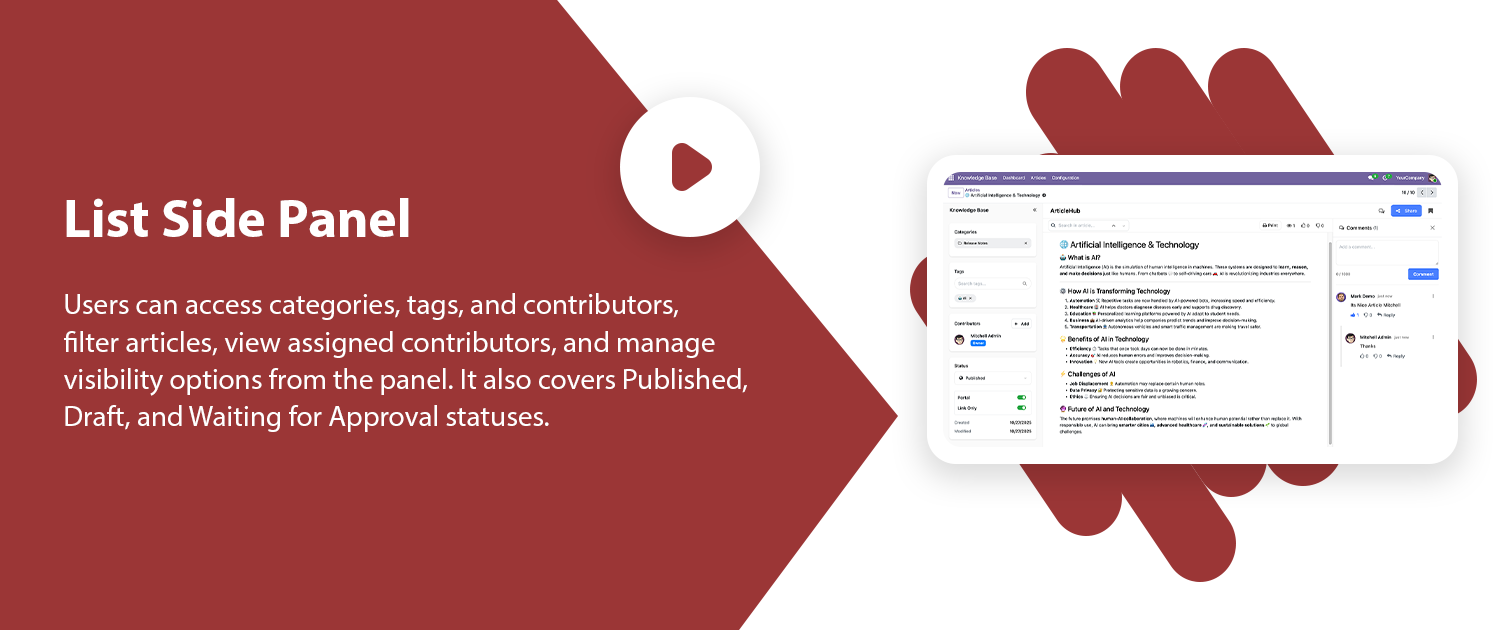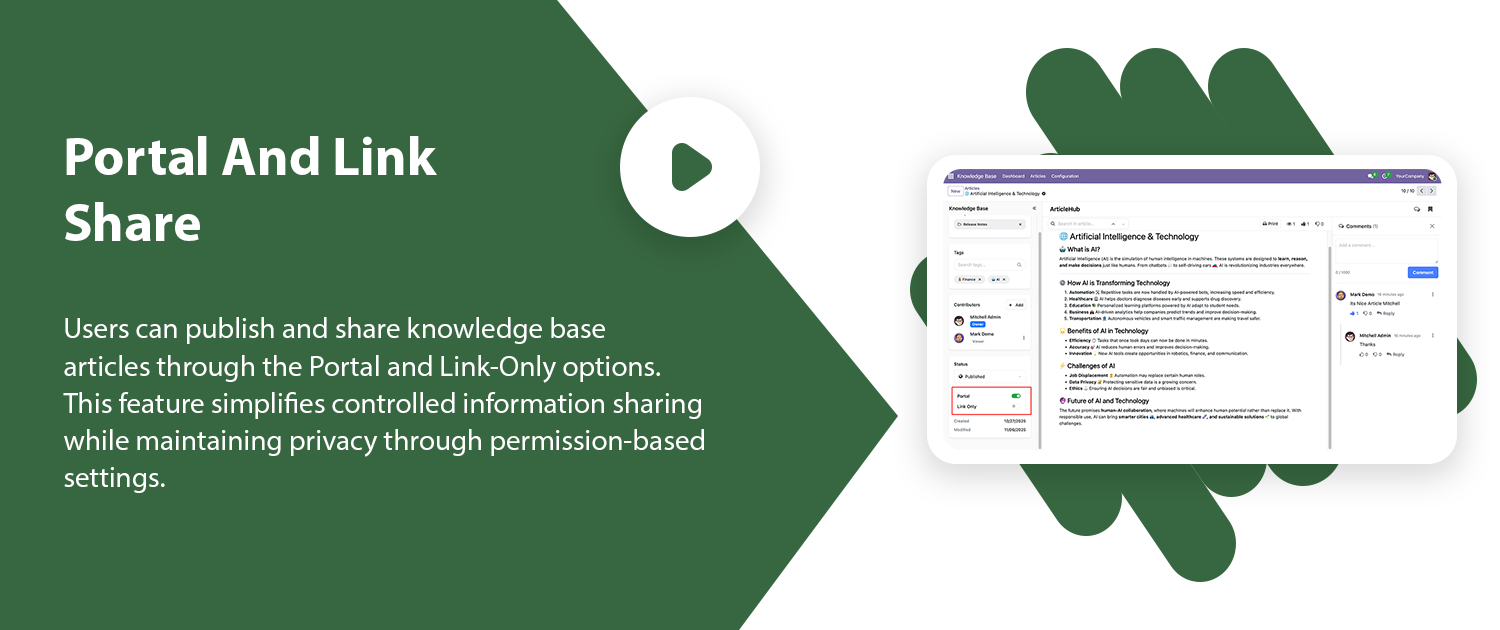


















Knowledge Base System

The Knowledge Base System module provides a collaborative space where teams can create, manage, and share information efficiently. It enables users to build articles, tags, and contributor roles to ensure smooth knowledge sharing across departments. Each article supports structured content with headings and formatted text, giving an engaging and easy to read experience.
You can assign contributors as editors or viewers, manage access rights, and maintain version control by switching between draft, approval, and published states. The portal and link-only options allow flexible visibility for both internal and external readers. Collaboration is enhanced with an integrated commenting system where team members can interact, reply, and react in real time. Articles can be shared through generated links, printed, or filtered by tags and categories. Overall, this module helps organizations centralize knowledge, promote teamwork, and maintain clear, accessible documentation for ongoing learning and improvement. It is also useful for creating and maintaining Standard Operating Procedures (SOPs), ensuring consistency and clarity in organizational processes.
Related Modules

Features


Knowledge Management
A centralized platform to record, manage, organize, and share knowledge keeping everything accessible, structured, and easy to use in one place.

User & Manager Roles
Separate user and manager roles with configurable access and security rights.

Portal View
Separate Portal View for external users or team members with limited access.
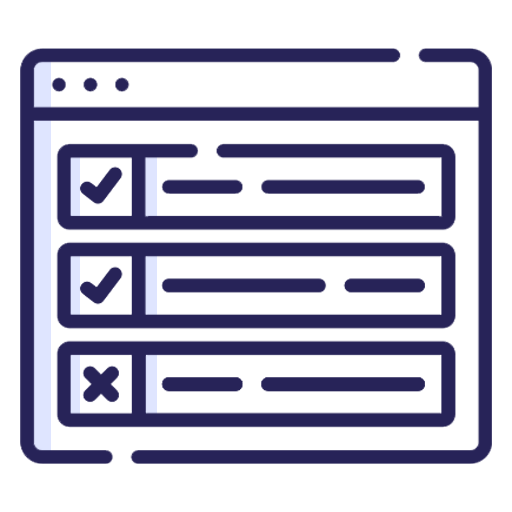
Manage Article Status
Define and manage article Status such as Draft, In Progress, and Published.

Manage Article
Create, edit, and manage articles with detailed content structure.

Dashboard
Centralized dashboard displaying a quick overview of all knowledge activities. Display of Total Articles, Published Articles, Drafts, and Contributors for quick insights.
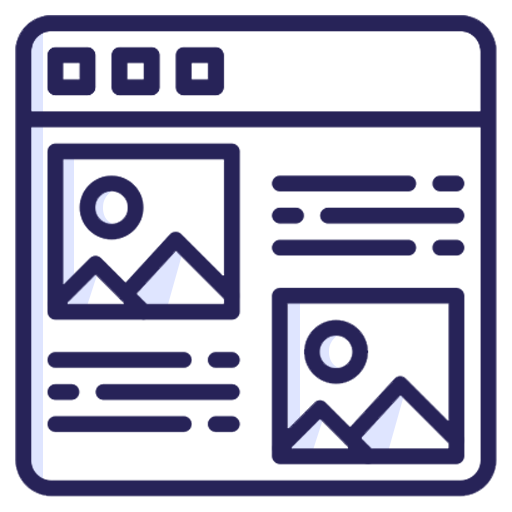
Share Article
Easily share article links within your organization and Assign multiple Contributors to articles for collaborative work.

Manage categories and Tags
Create and manage article categories and tags for structured organization.

Track Activities
Track recent articles, most viewed, and most liked directly from the dashboard.

Manage Article Visibility
Control article visibility through publish and unpublish options.

Like and Comment Article
Users can like and comment on articles for feedback.
The user access configuration where the Knowledge Base role is assigned.
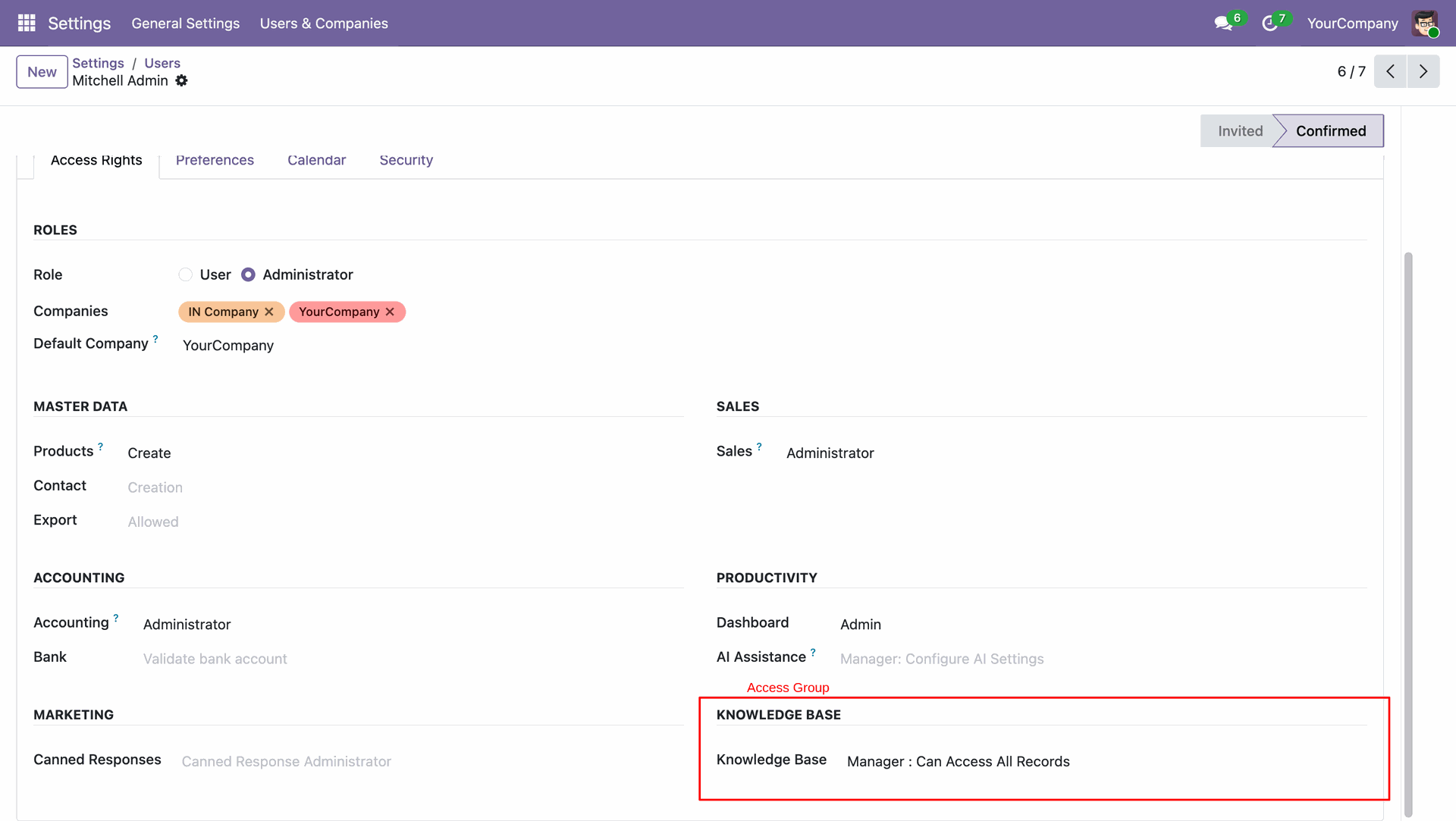
Set user access for the Knowledge Base module. You can choose between two roles - User, who can access their own and public documents, or Manager, who can access all records. Assign the appropriate access group as per your organizations requirement.
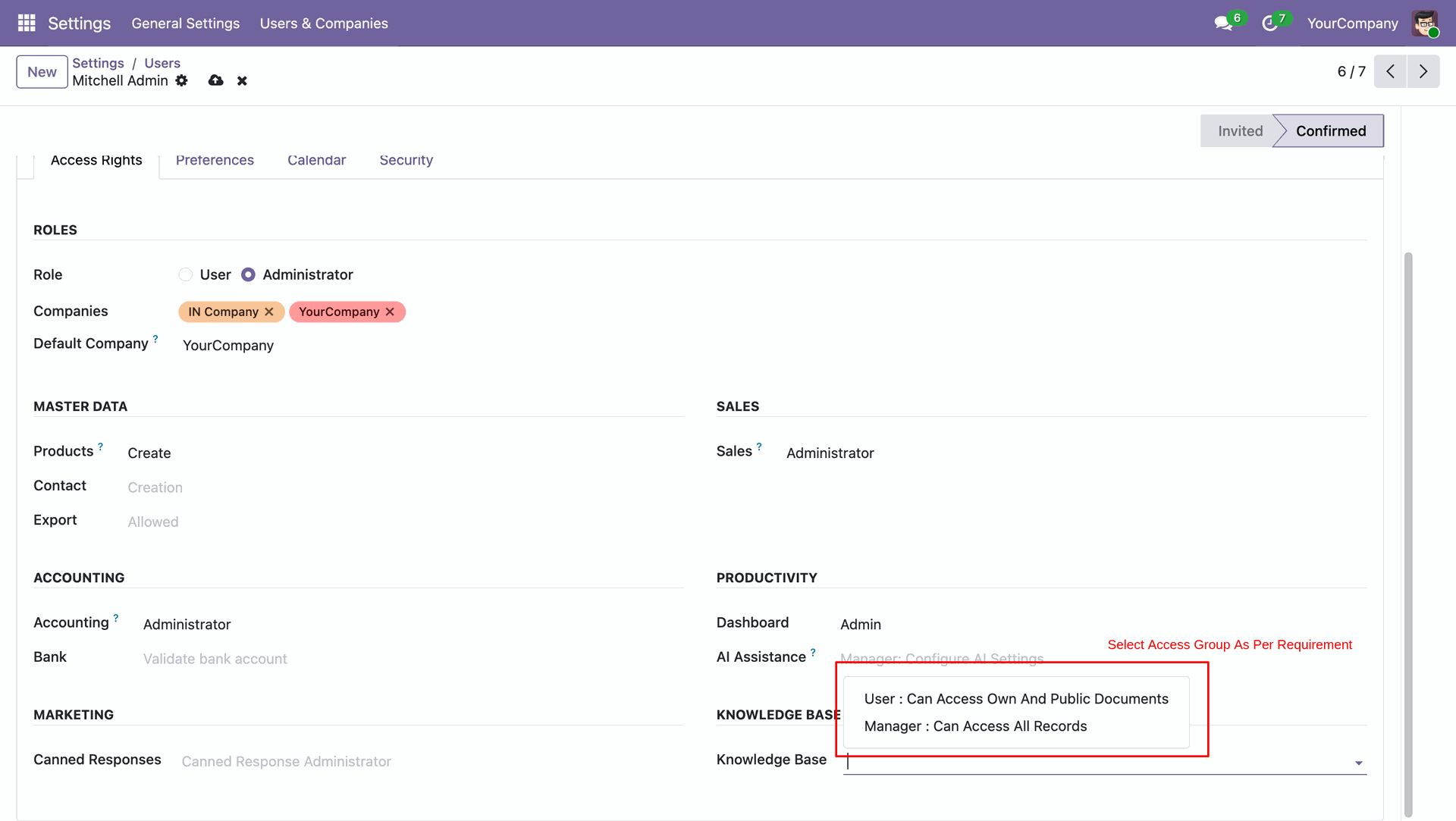
Configuration menu for categories and tags.
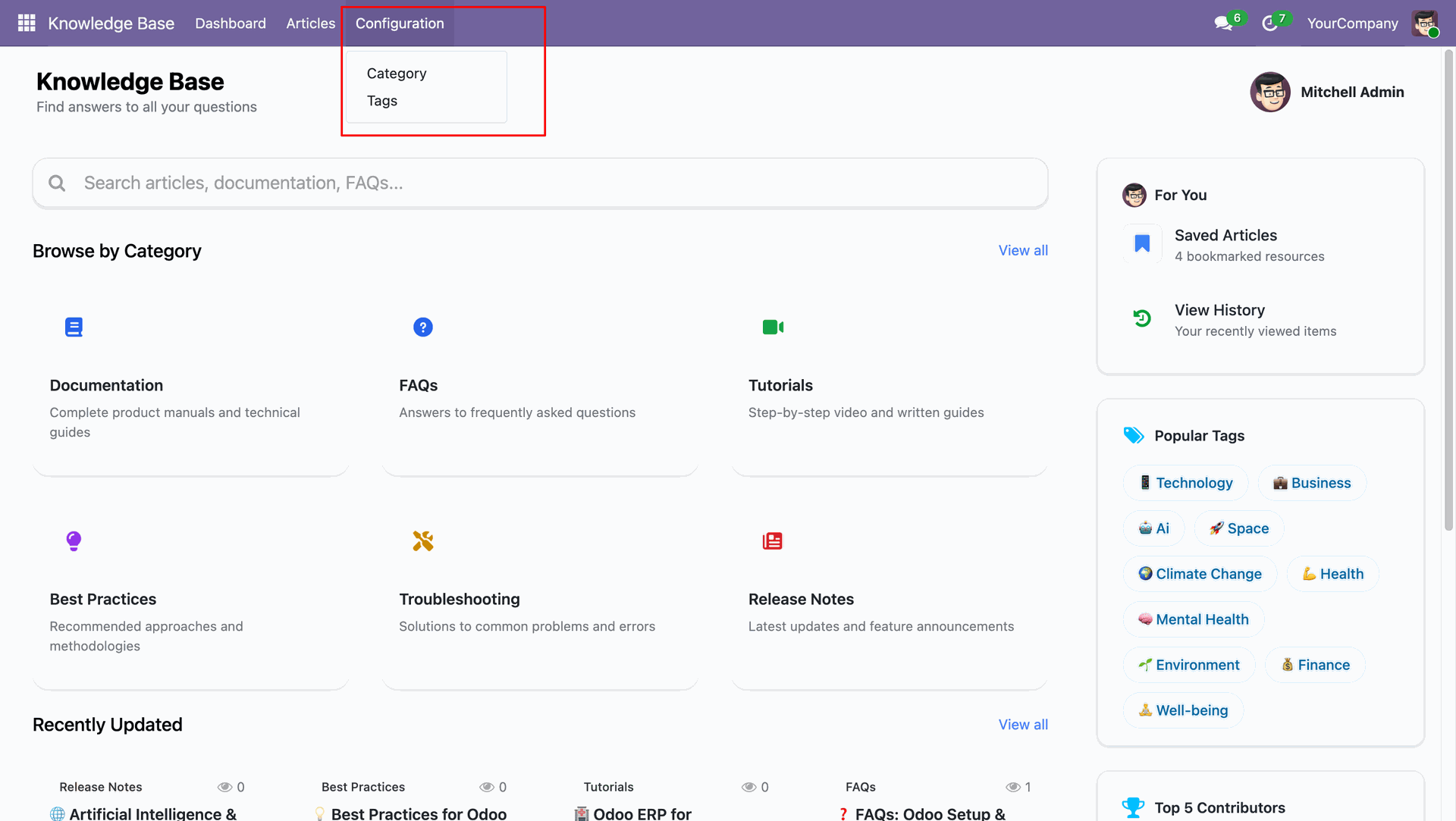
Now we navigate to the Category section for managing and organizing Knowledge Base content.

Category list view showing all defined Knowledge Base categories for organized content management.

Form view for creating or editing a category with title, description, and relevant information.
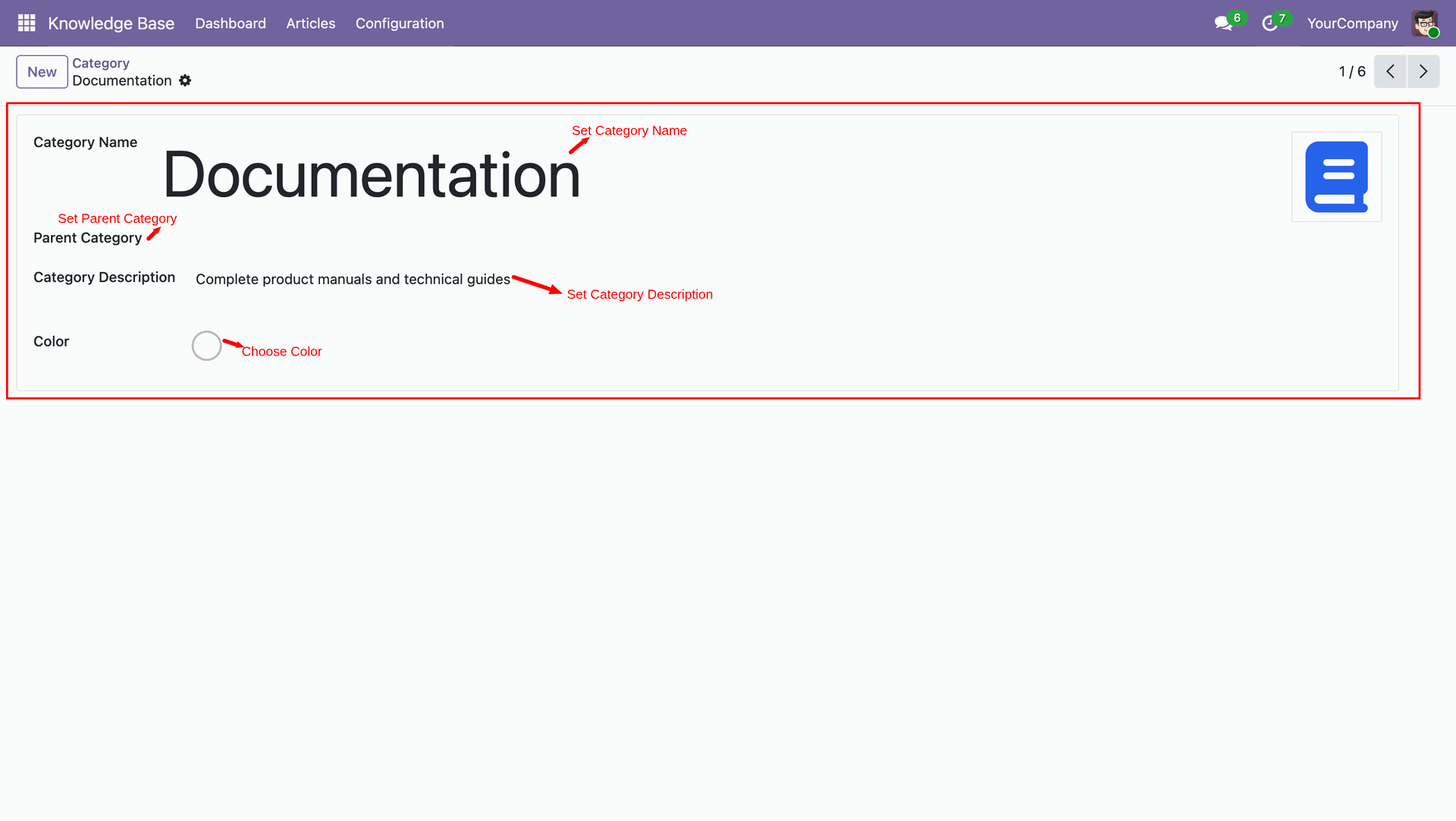
Tags menu for creating and managing tags.
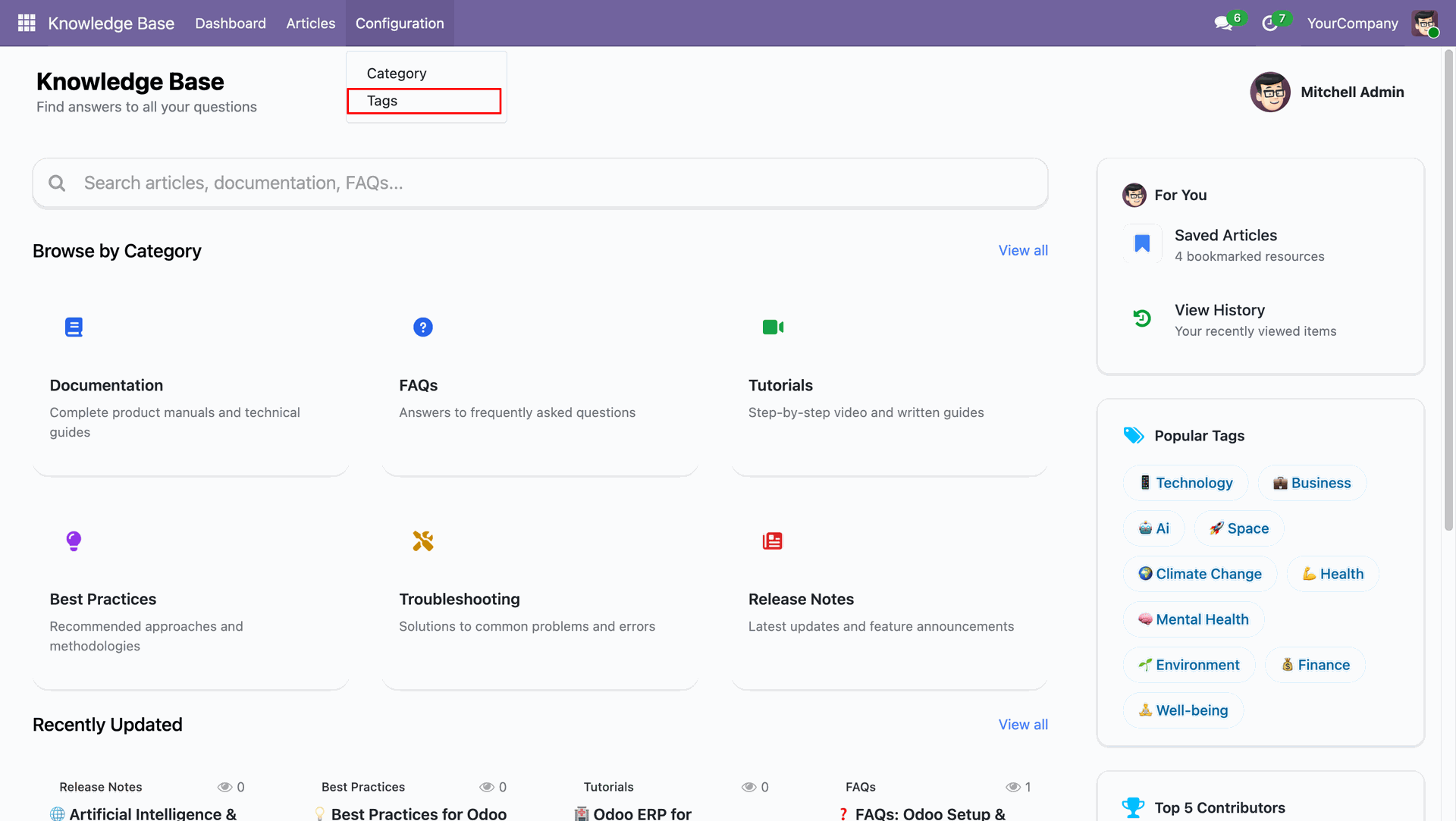
Tag list view showing all defined Knowledge Base tags.
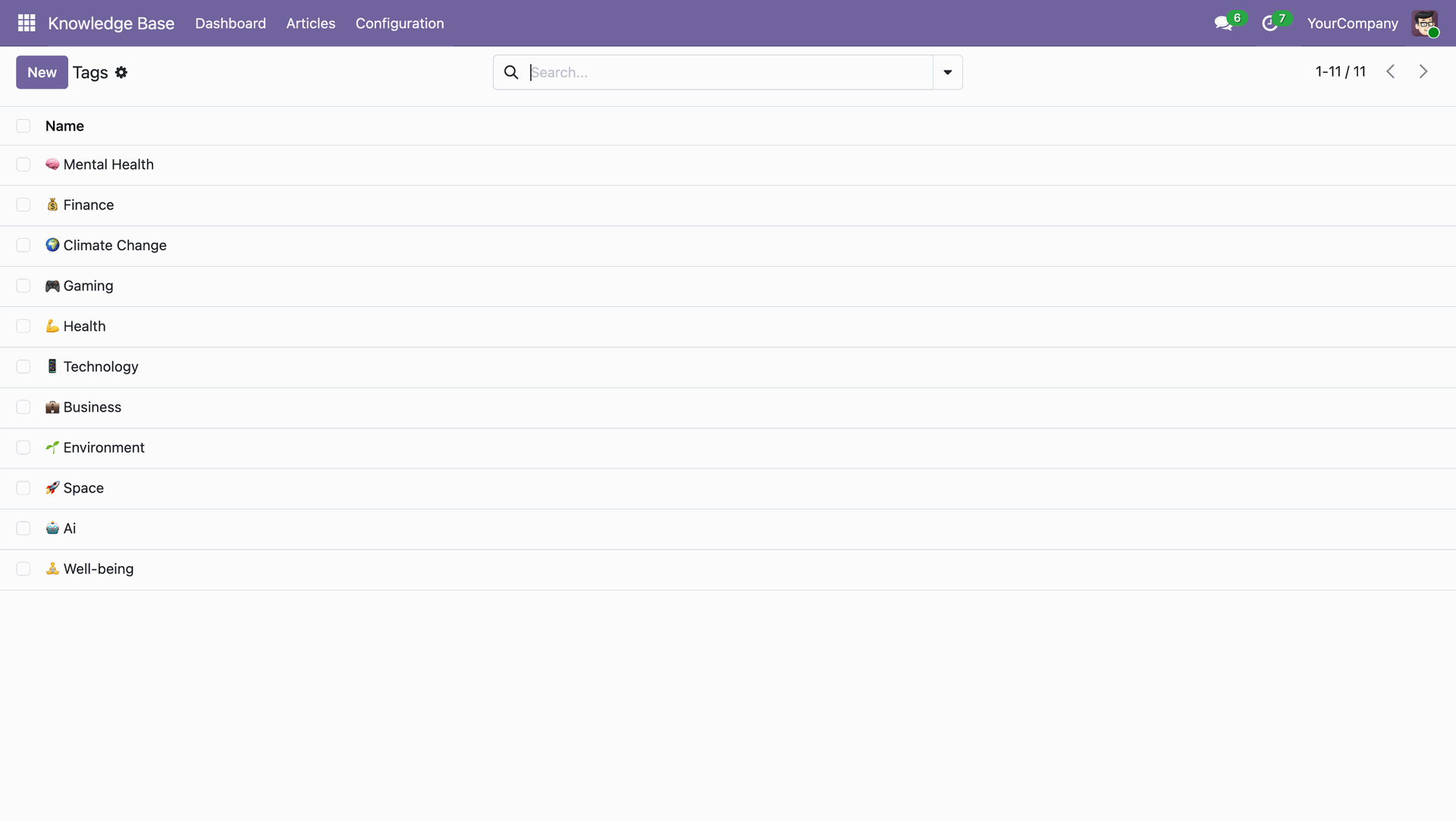
Tag form view.
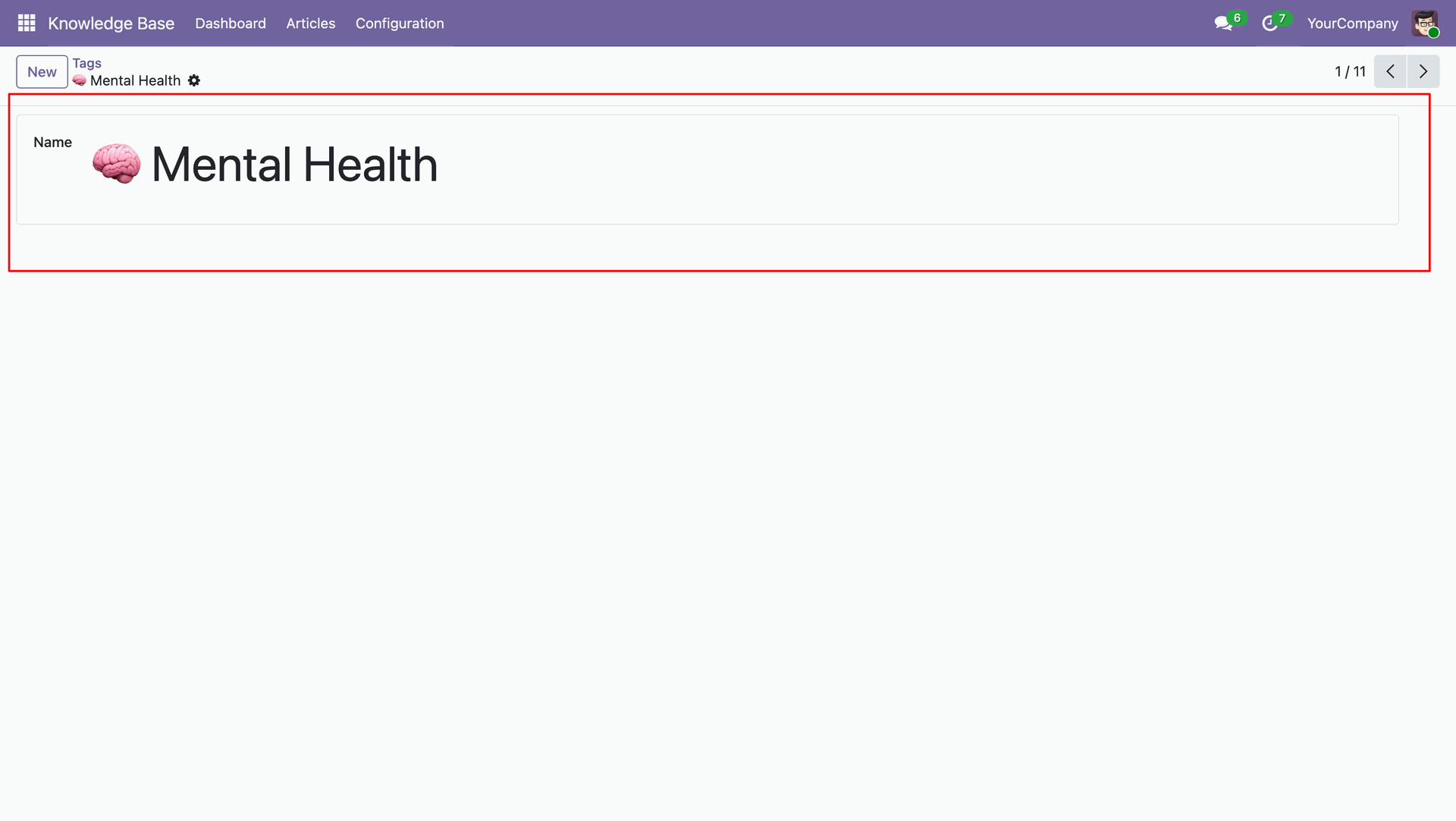
This screen shows the Articles menu with all knowledge base articles displayed in a kanban view. You can filter by category, tags, or author, and view details like summary, views, and last updated date.
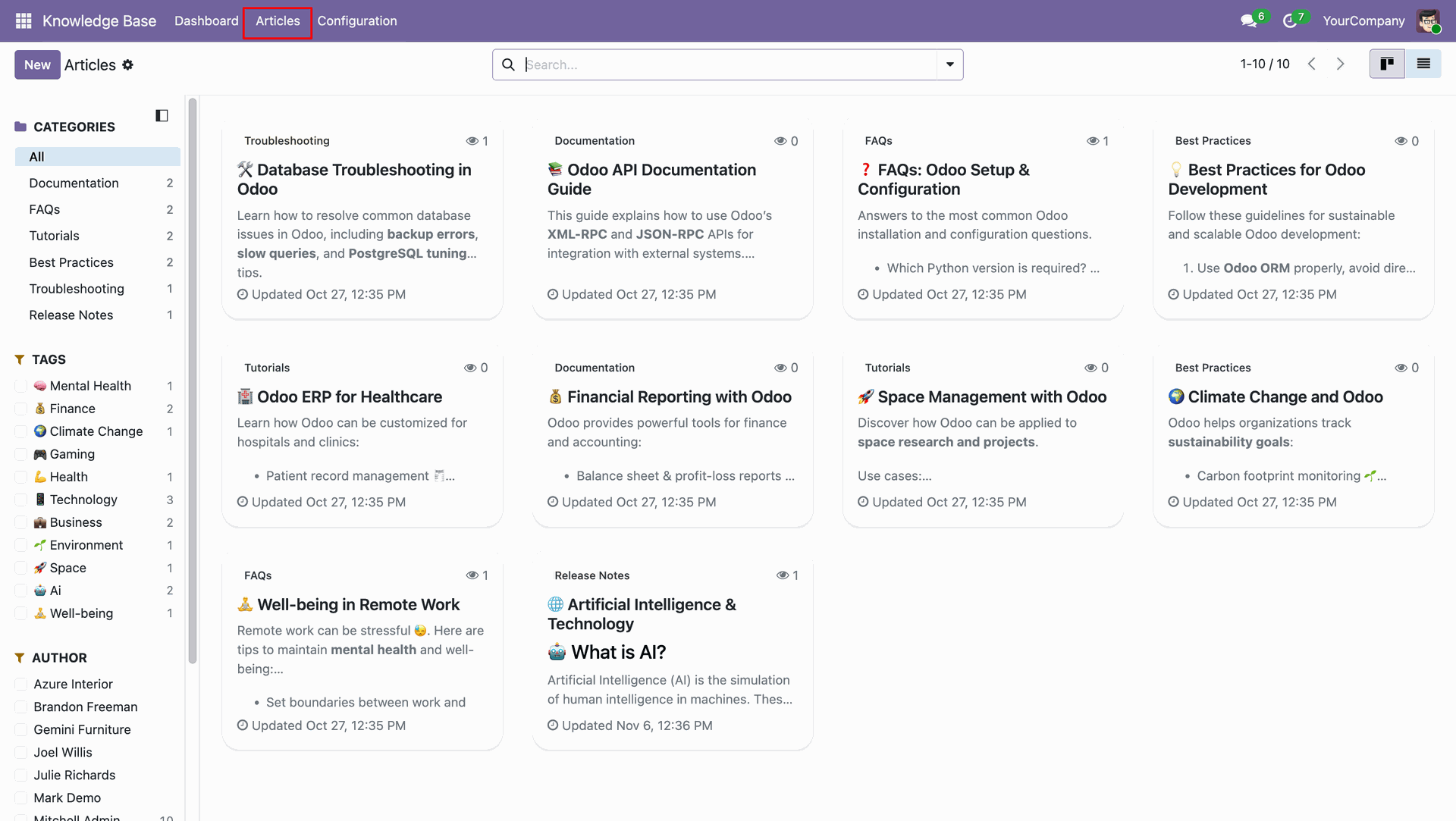
This view lists all articles in list view with details like title, category, tags, author, update time, and publication status.
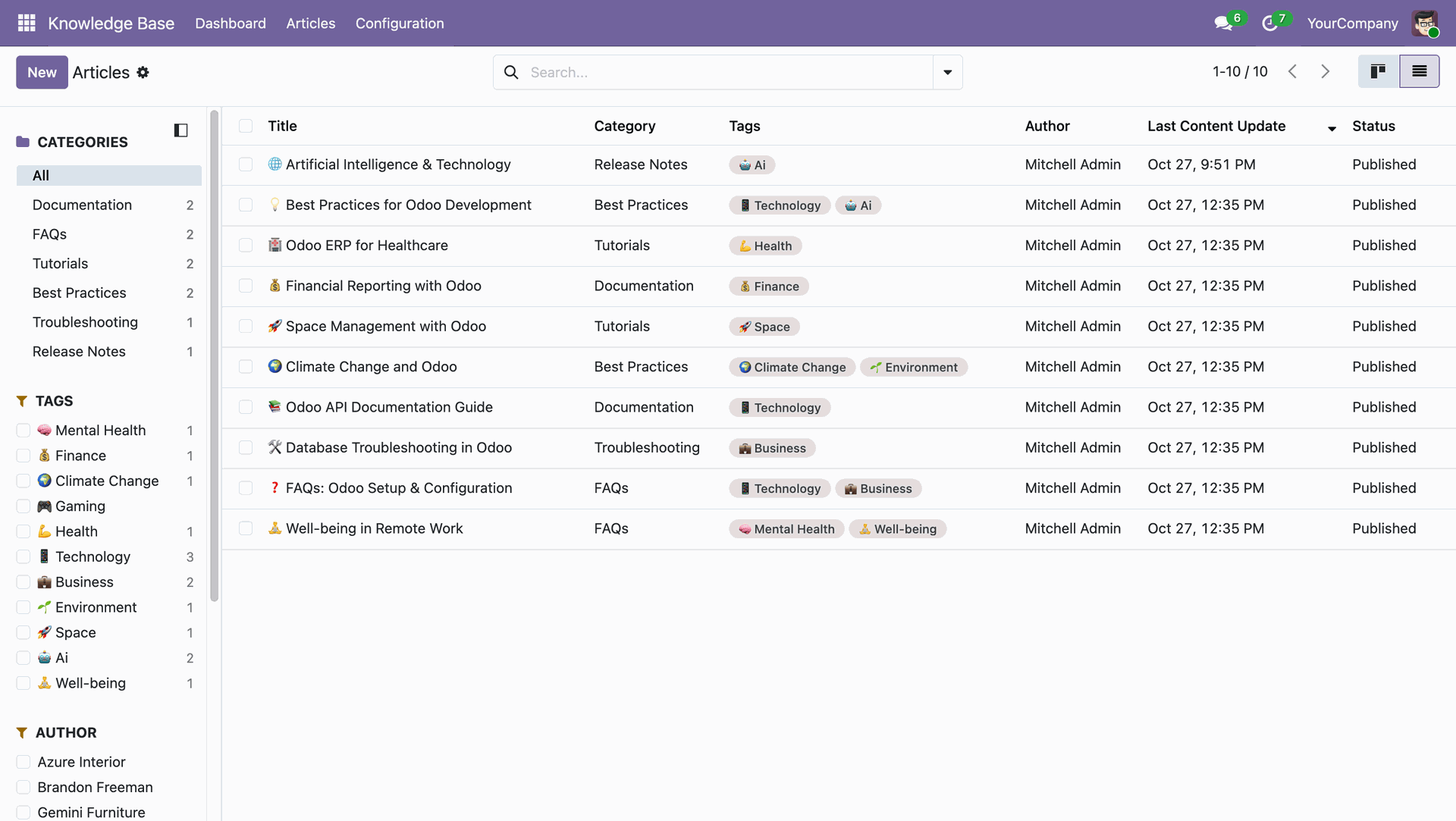
Article detailed view showing content, author info, category, tags, publication status, and user comments.
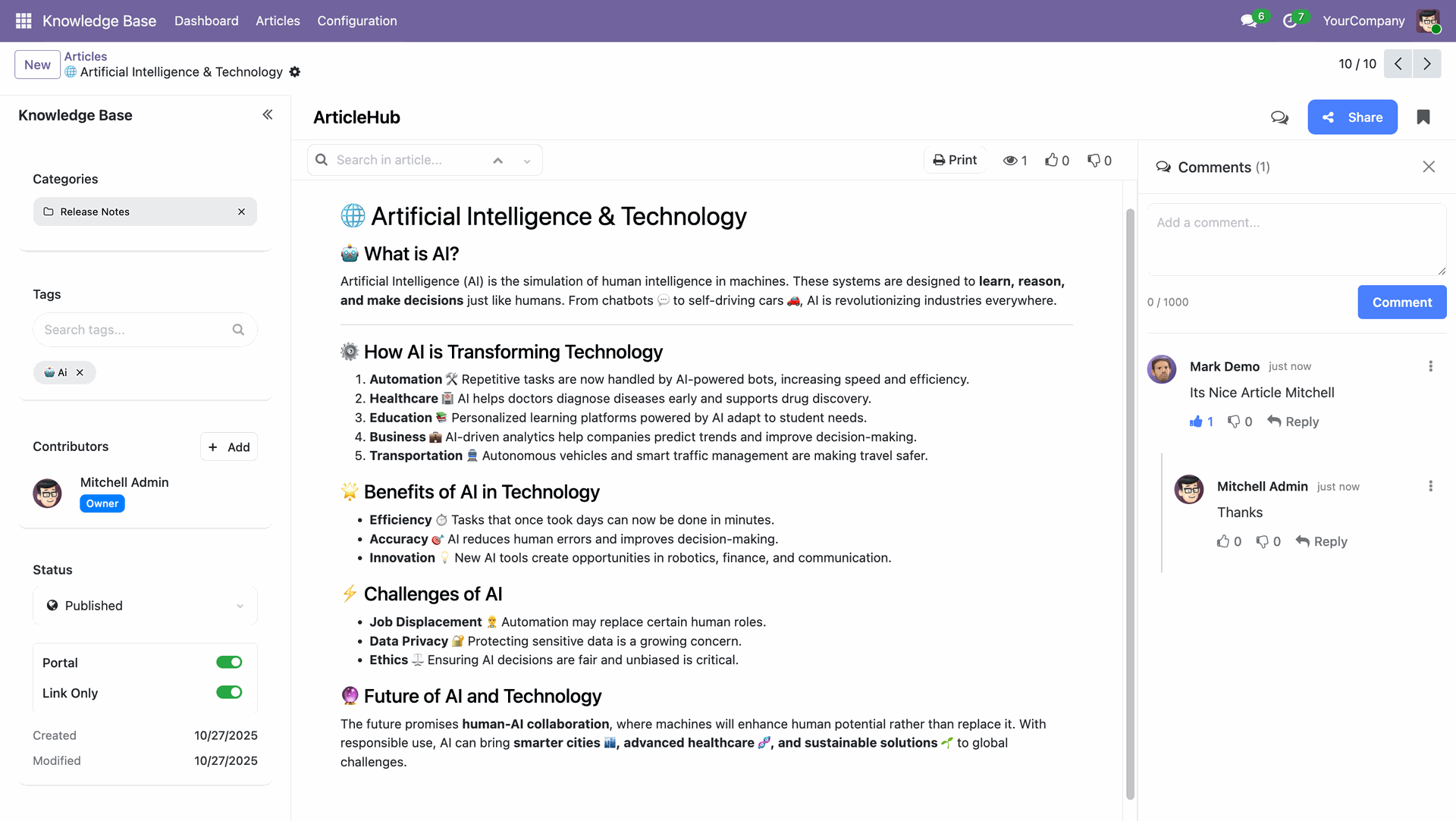
You can set categories and tags to organize your knowledge base articles. Categories group articles under main topics like documentation or release notes, while tags add extra context such as ai or finance for better filtering and quick access to related content.
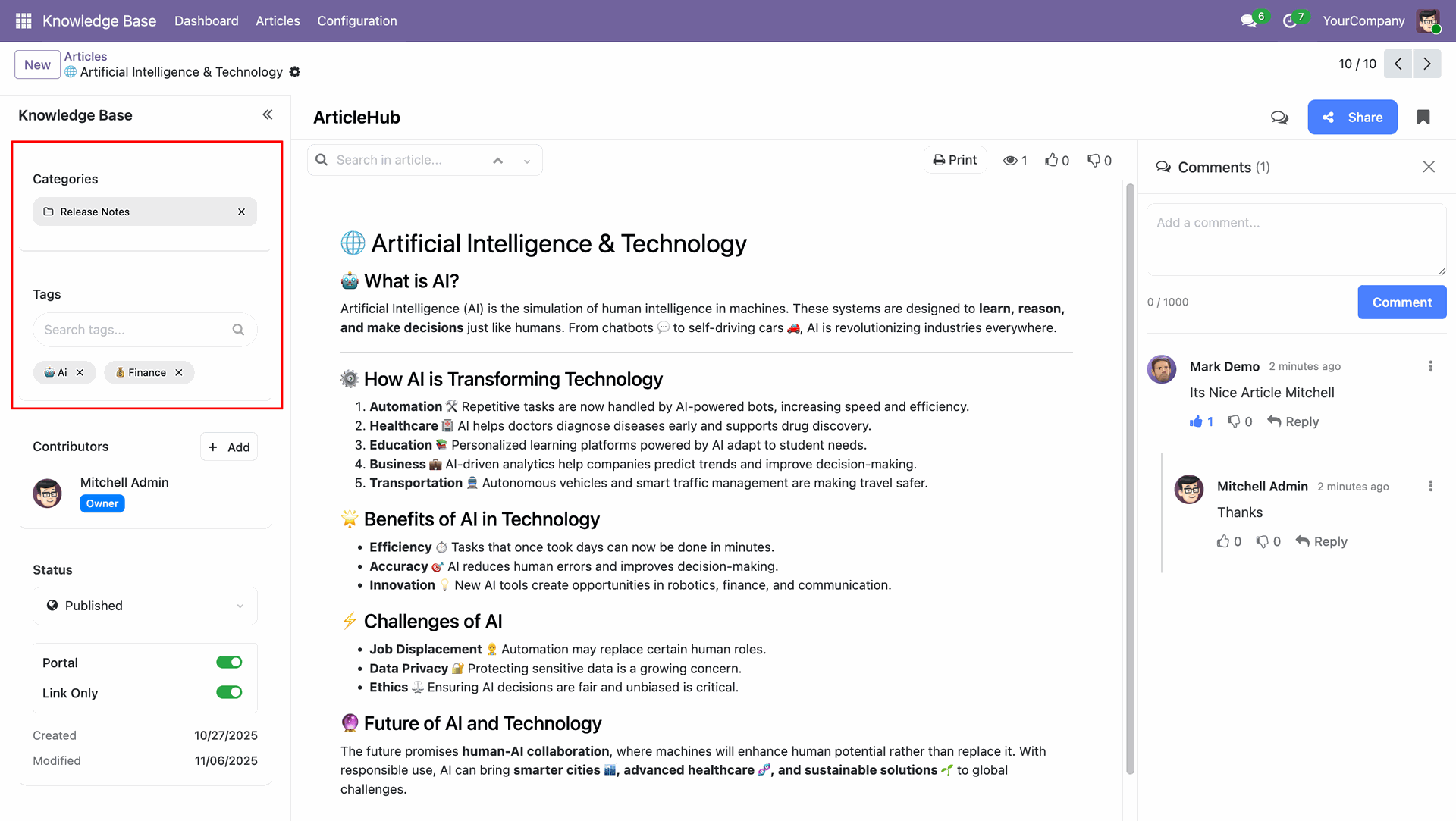
You can use the comments section to collaborate with other users by adding feedback or suggestions on articles. Team members can reply, like, or discuss directly within the comment thread, keeping communication organized and article improvement efficient.
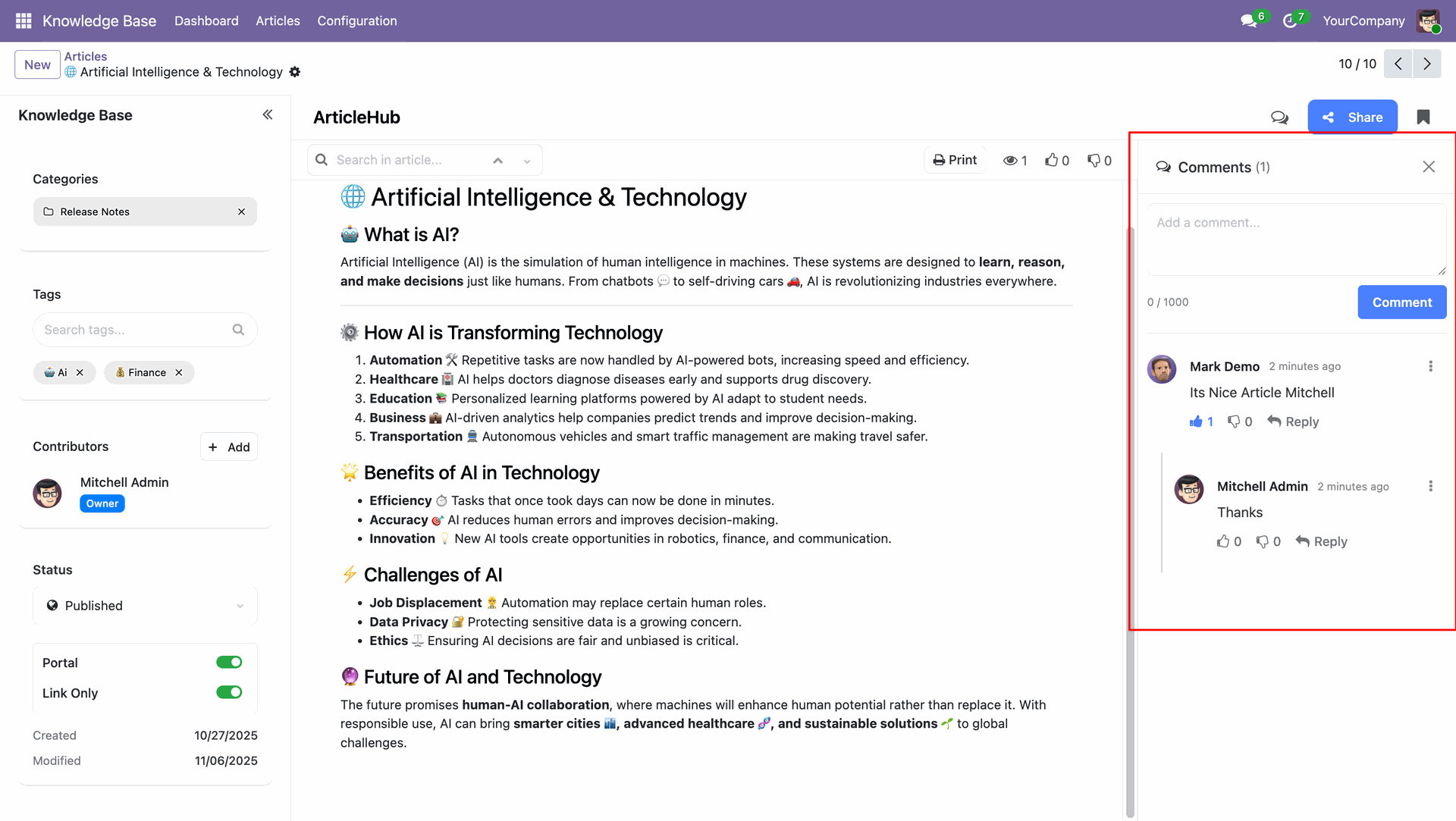
You can edit or delete your comments anytime using the menu beside each comment. This helps keep discussions clean and allows you to update or remove feedback when needed.
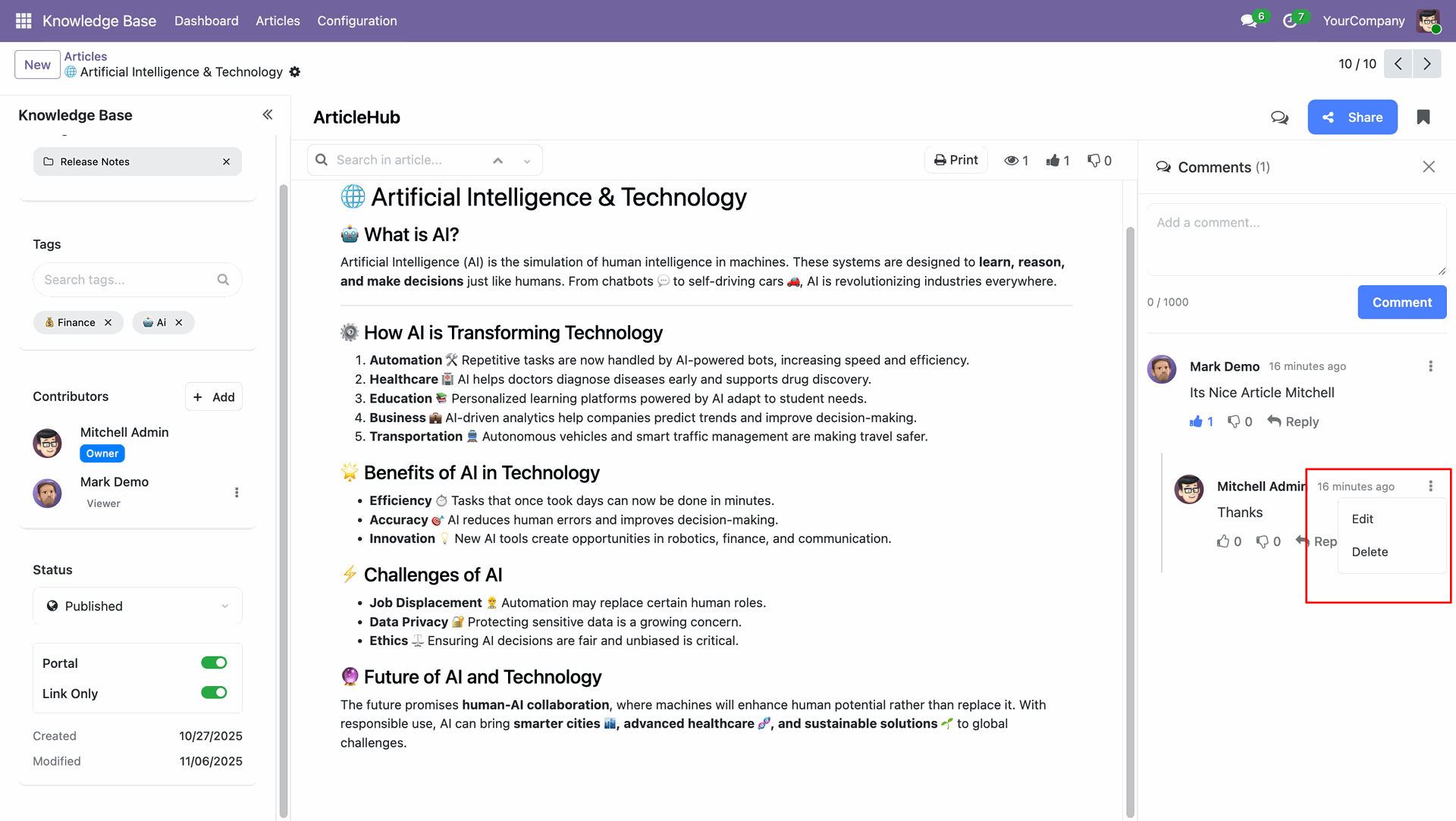
The highlighted section displays the article toolbar, which includes quick actions and insights. You can use it to search for articles, filter results, print the current article, and view engagement metrics such as views, likes, and dislikes - all helping manage and track content performance efficiently.
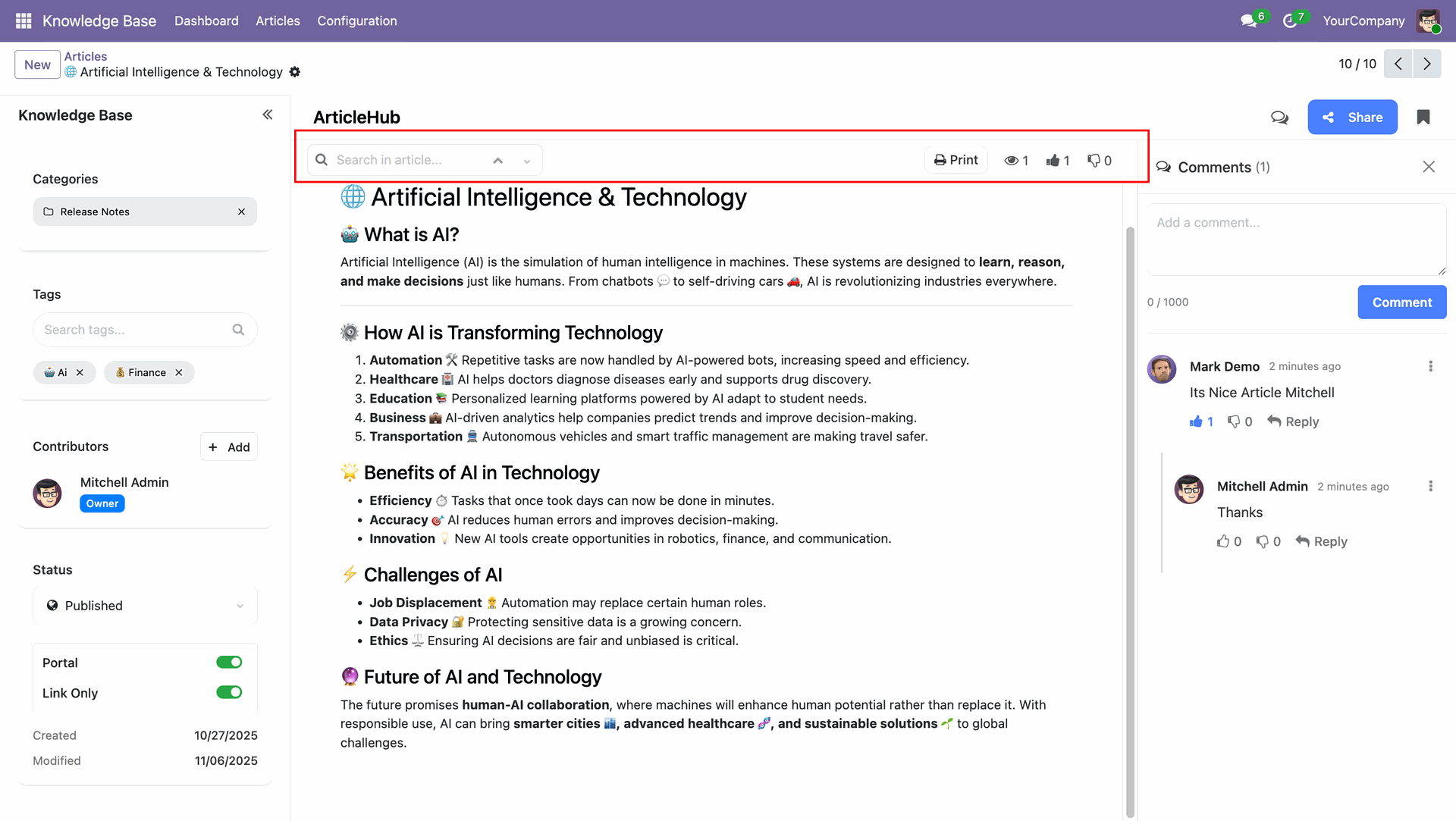
You can set a bookmark for any article using this icon, allowing you to quickly access and manage your favorite or frequently used articles from your saved list for faster navigation.

You can set contributors by selecting a user and assigning a role such as Editor or Viewer, allowing collaborative management and editing of the article as per their assigned permissions.
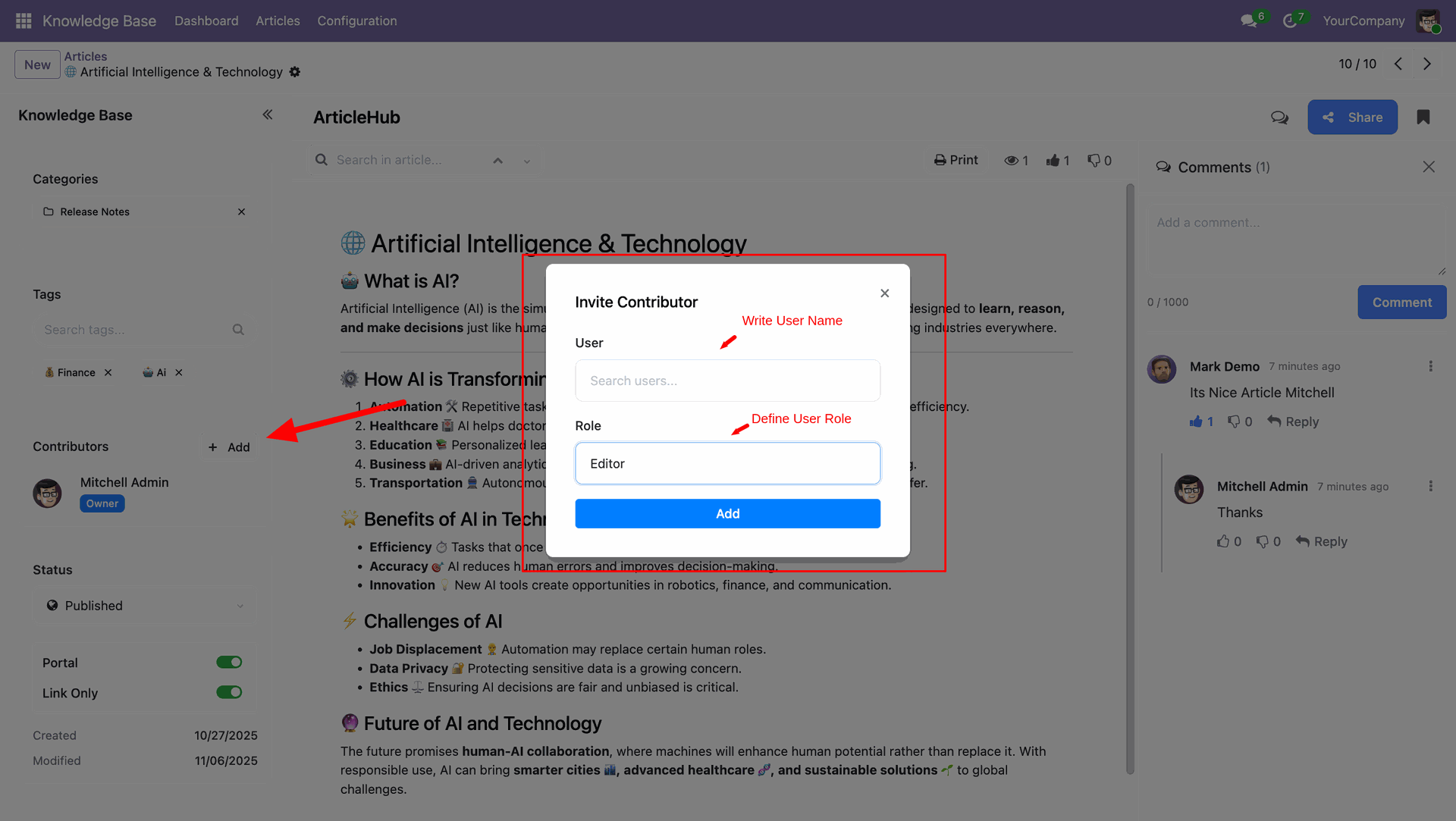
You can set a contributor by typing a users name in the search field, then selecting from the suggested list to quickly assign the desired user as a collaborator for the article.
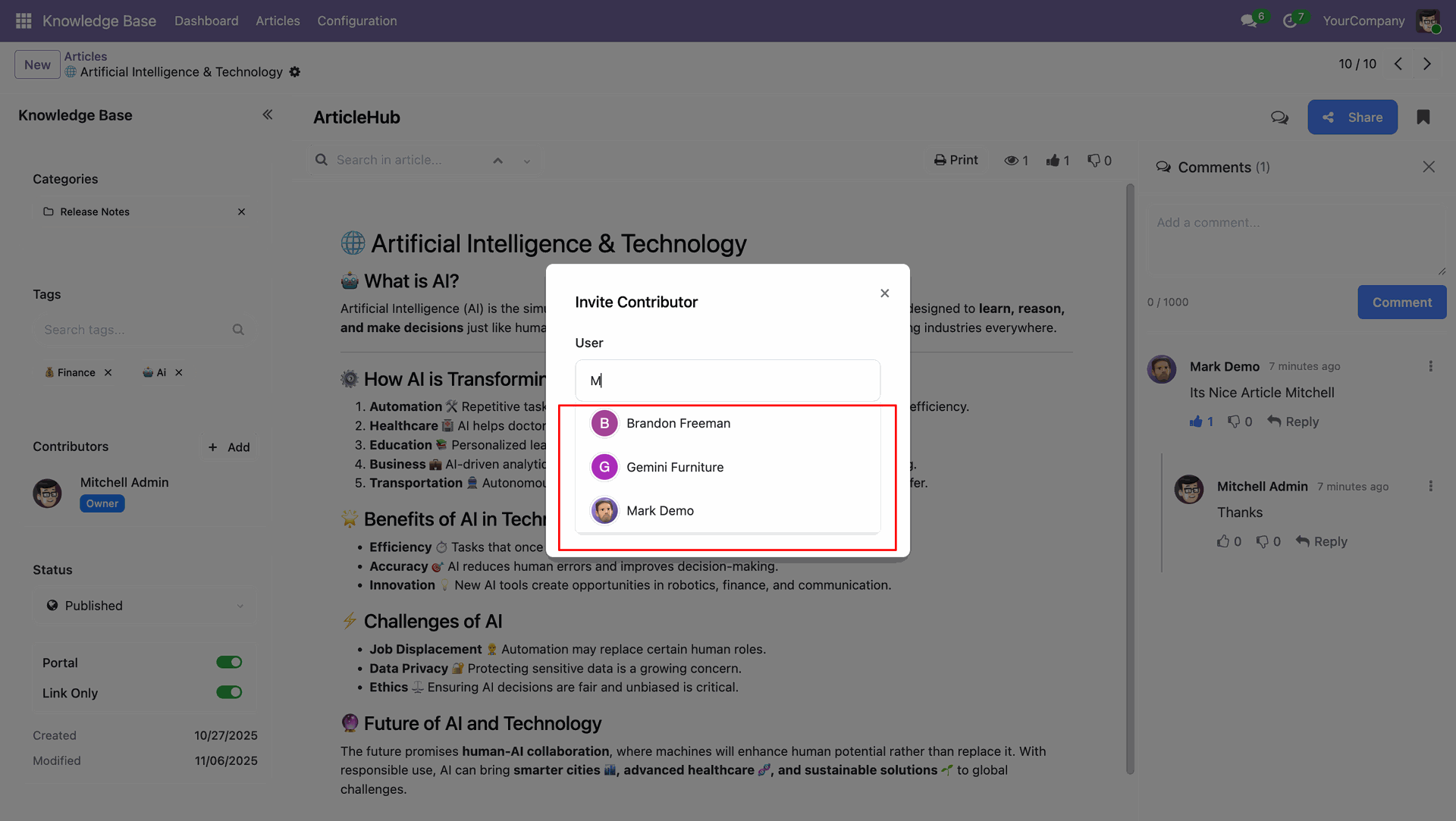
You can set the contributor role by choosing between Editor or Viewer to define their level of access before adding them to the article.
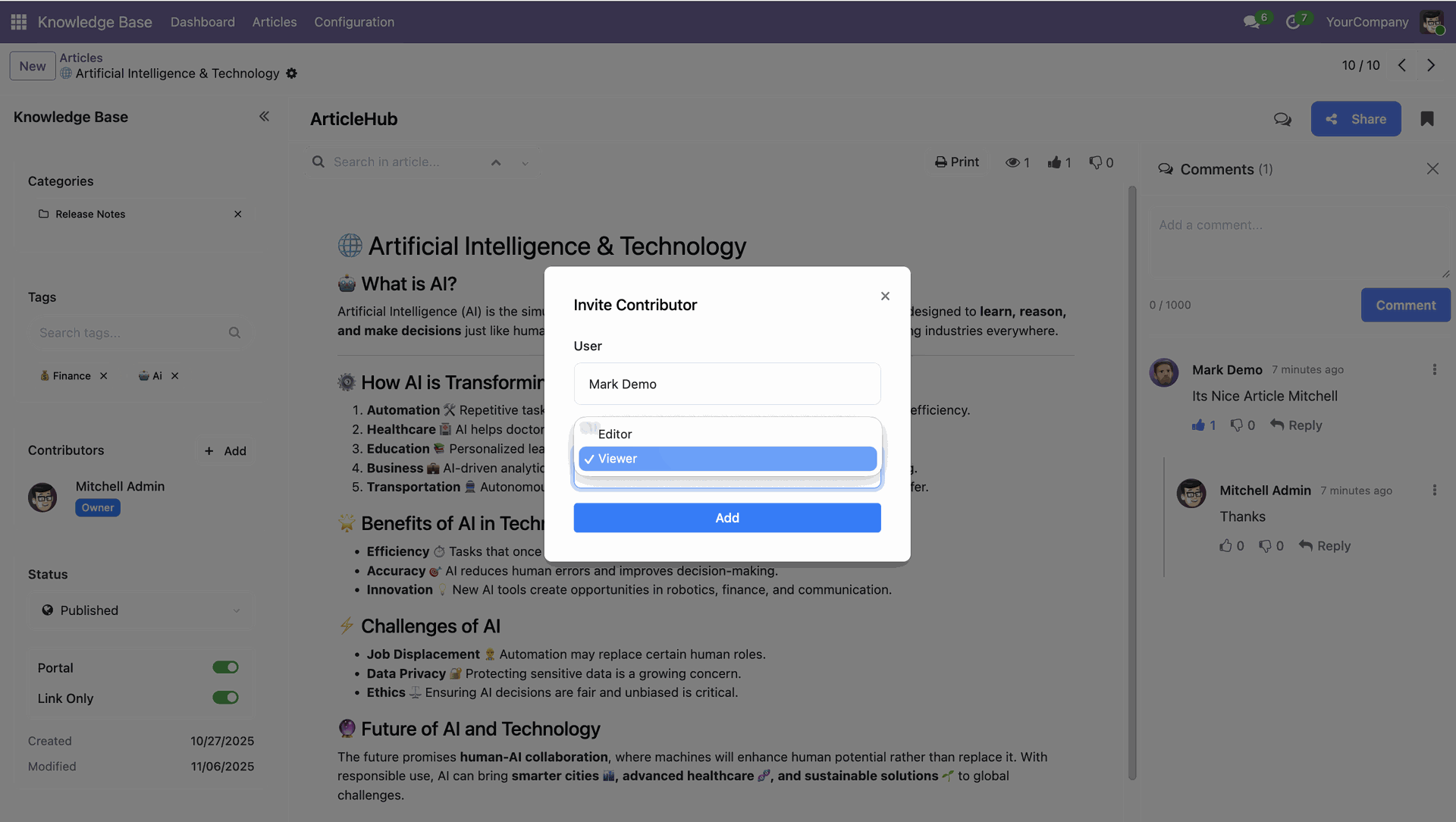
You can manage contributors by updating their role from viewer to editor or removing them from the list when needed.
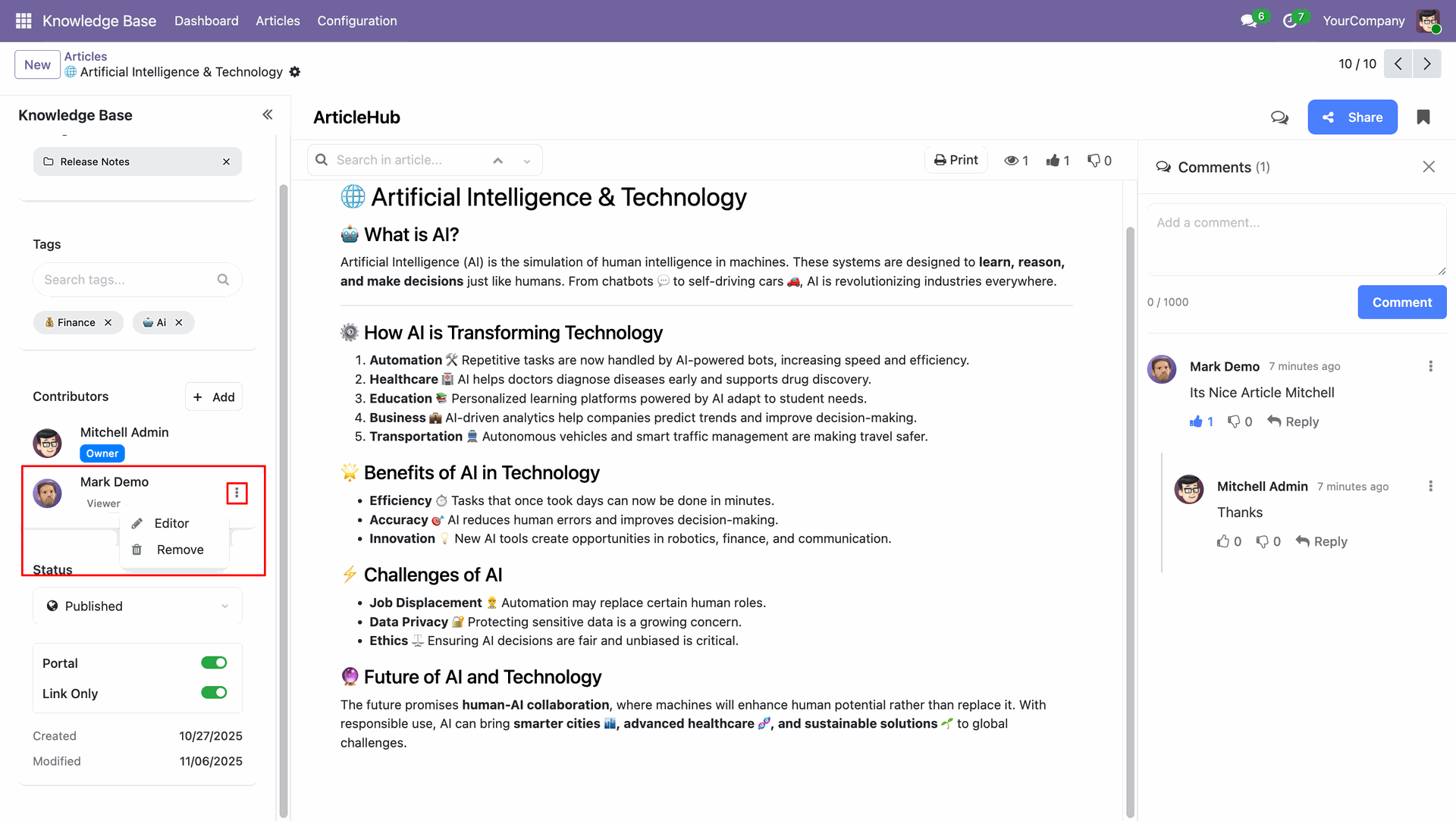
You can set the article status as Published, Draft, or Waiting for Approval based on its review stage.

You can control the articles visibility using Portal and Link Only options.

You can share the article with others using the Share button, which provides options to generate a link or invite specific contributors for collaboration.
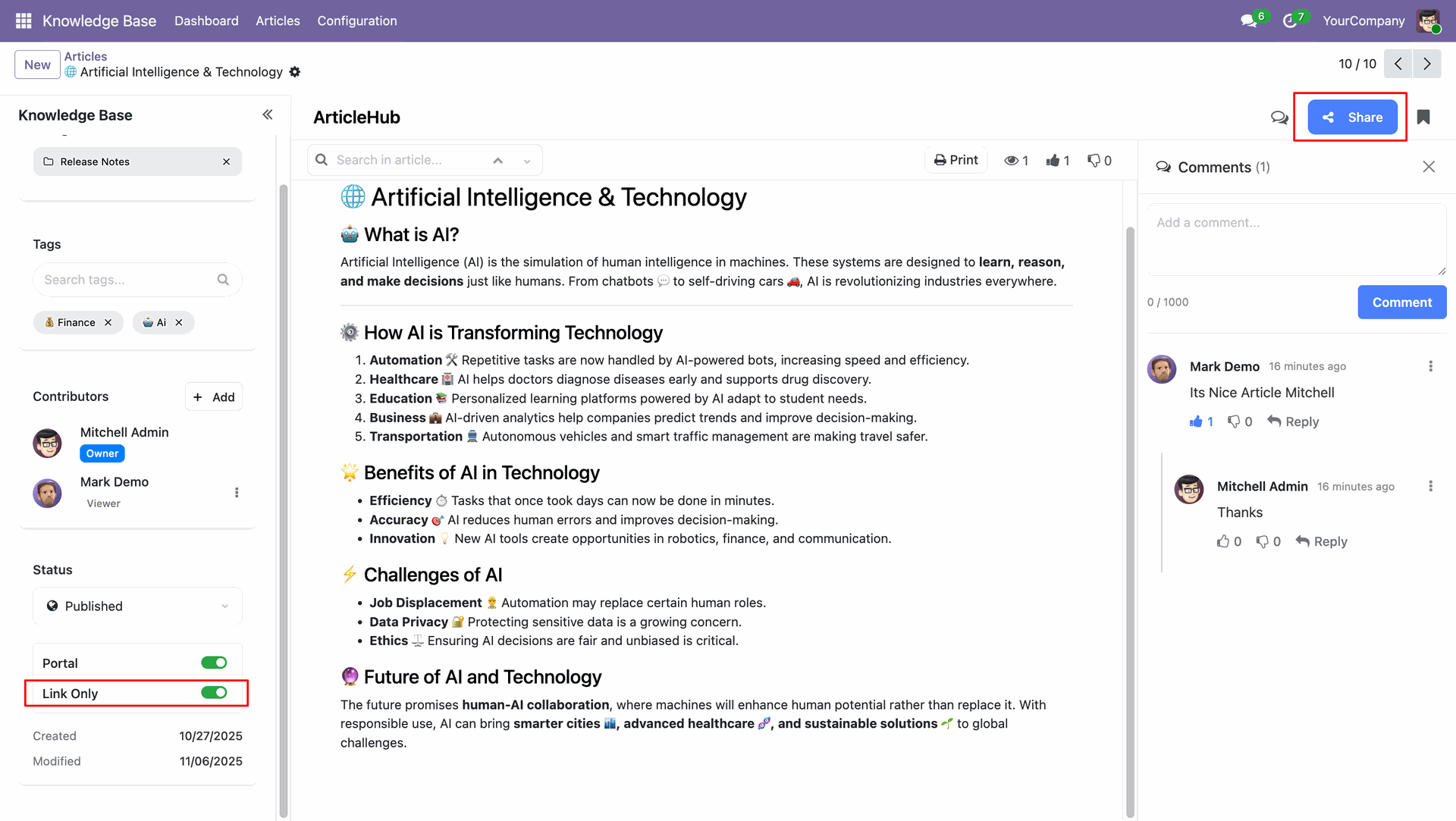
A shareable article link is generated, allowing anyone with the link to view the article based on the defined visibility settings.
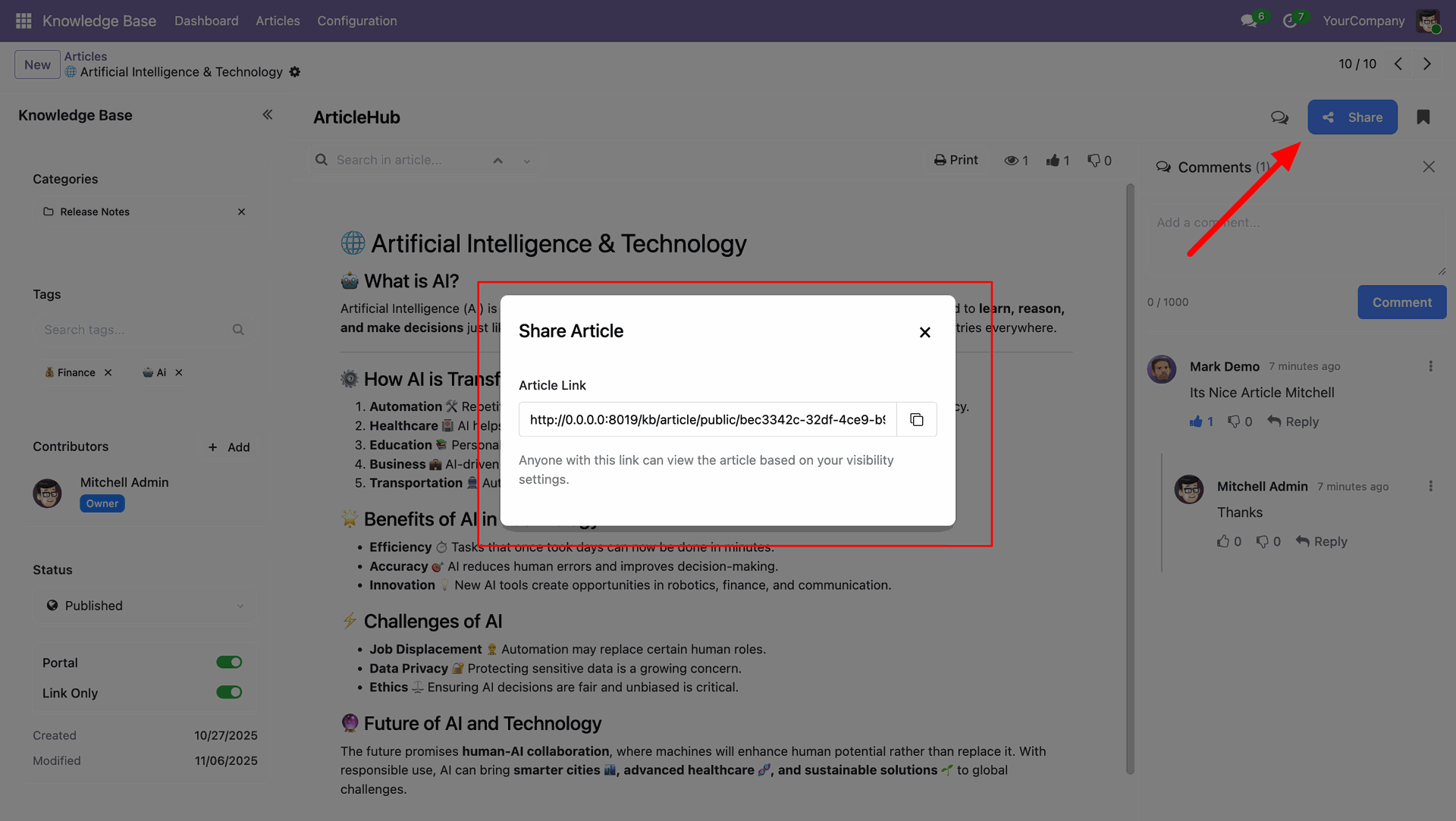
You can open the left-side panel by clicking the double-arrow icon. You can also view the comments section using the comment icon on the top bar to collaborate and share feedback.
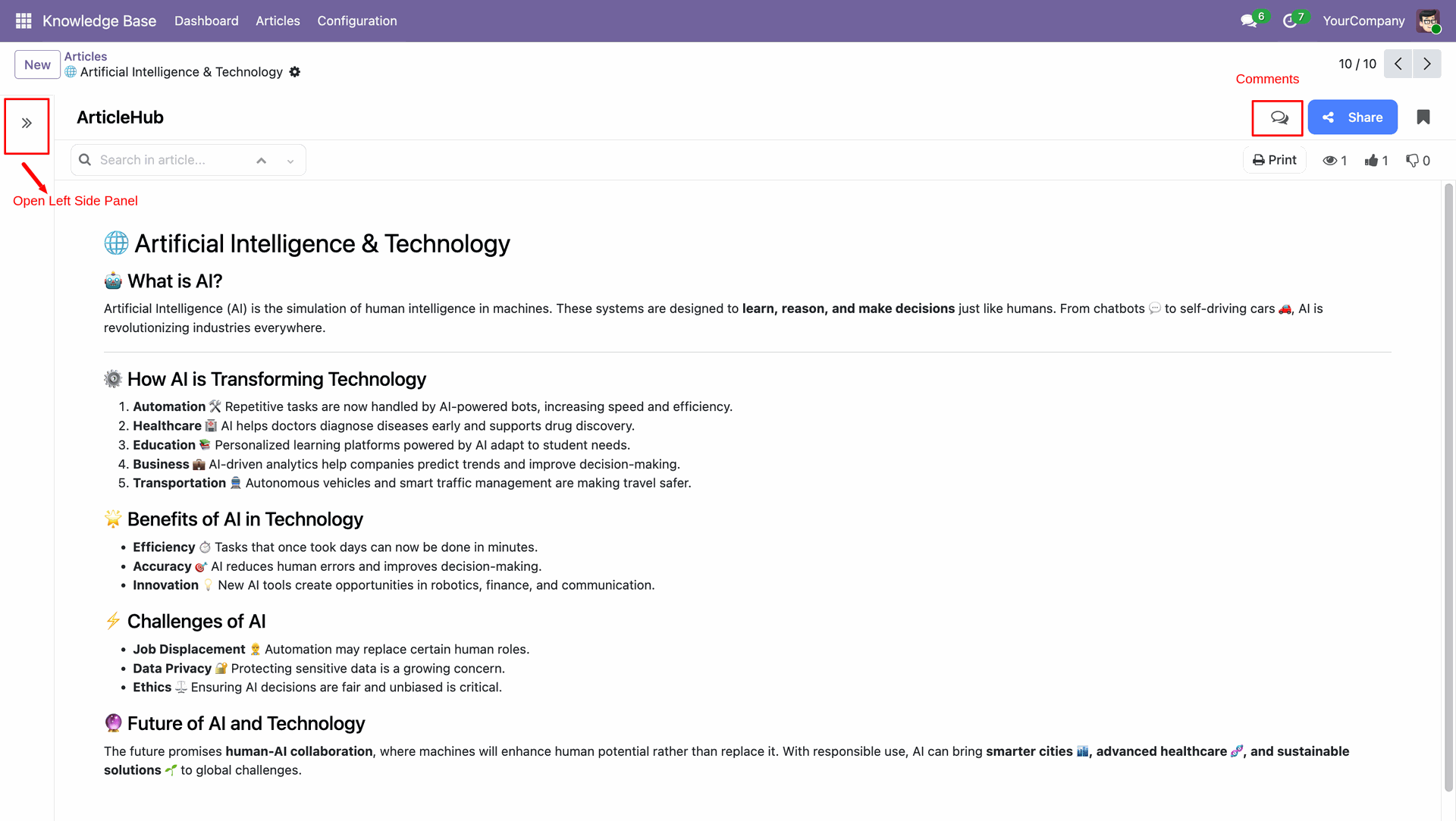
The Knowledge Base Dashboard provides an organized view with sections for browsing by category, recently updated and trending articles, personalized options like saved articles and view history, popular tags for quick filtering, and a list of top contributors.

The Browse by Category section provides quick access to different knowledge areas such as Documentation, FAQs, Tutorials, Best Practices, Troubleshooting, and Release Notes. Users can click View All to explore the complete list of categories and access more detailed information.
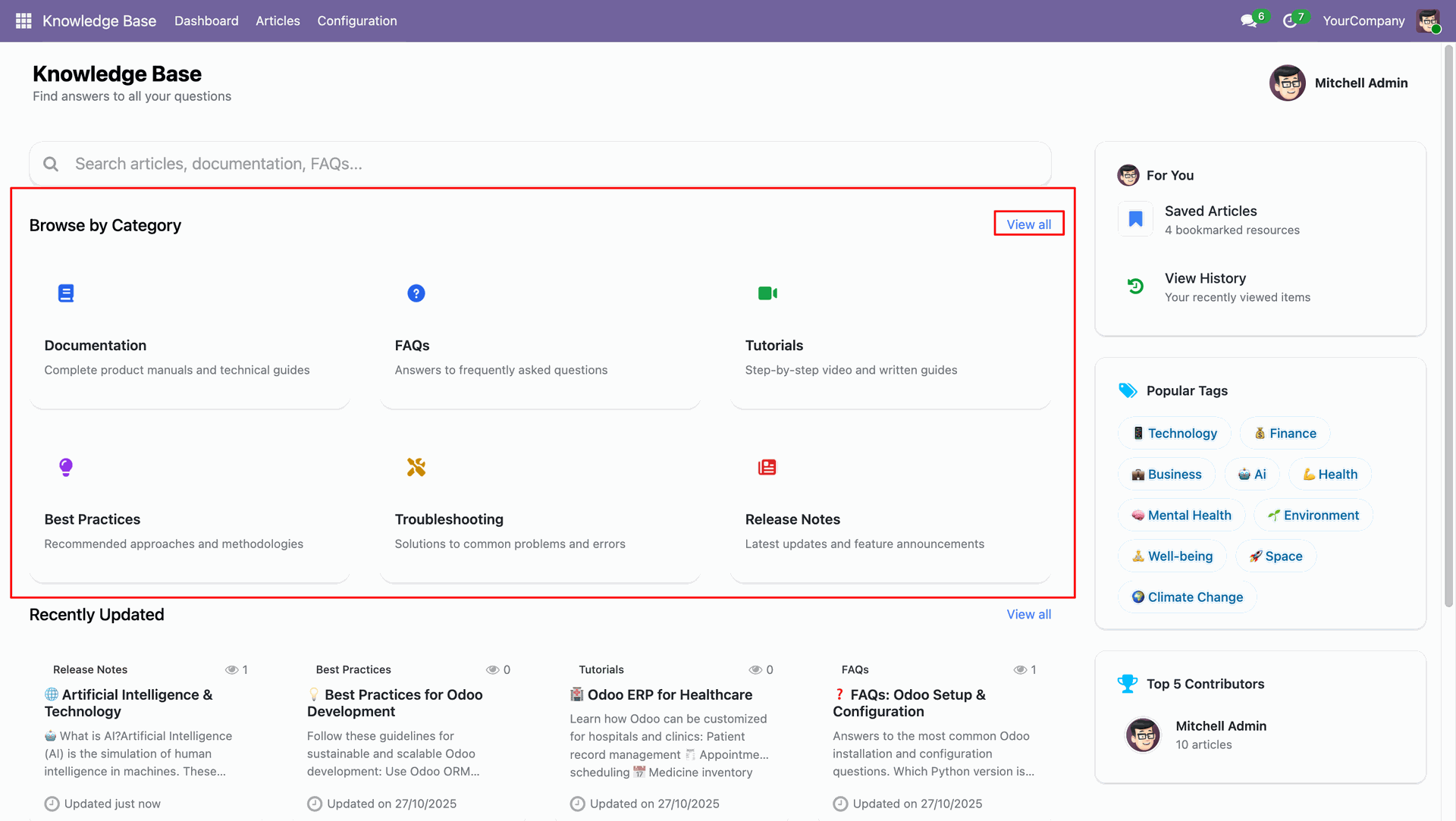
This section displays all knowledge base articles organized under their respective categories. Each record shows the article title, category, associated tags, author, last updated date, and publication status. Users can easily expand or collapse categories to view related articles for better navigation and management.

This section displays Recently Updated and Trending Articles. It highlights the latest content modifications and the most-read articles for quick access. Each card shows the article title, category, brief summary, update date, and view count. Users can click View All to explore the complete list of updated or trending articles.
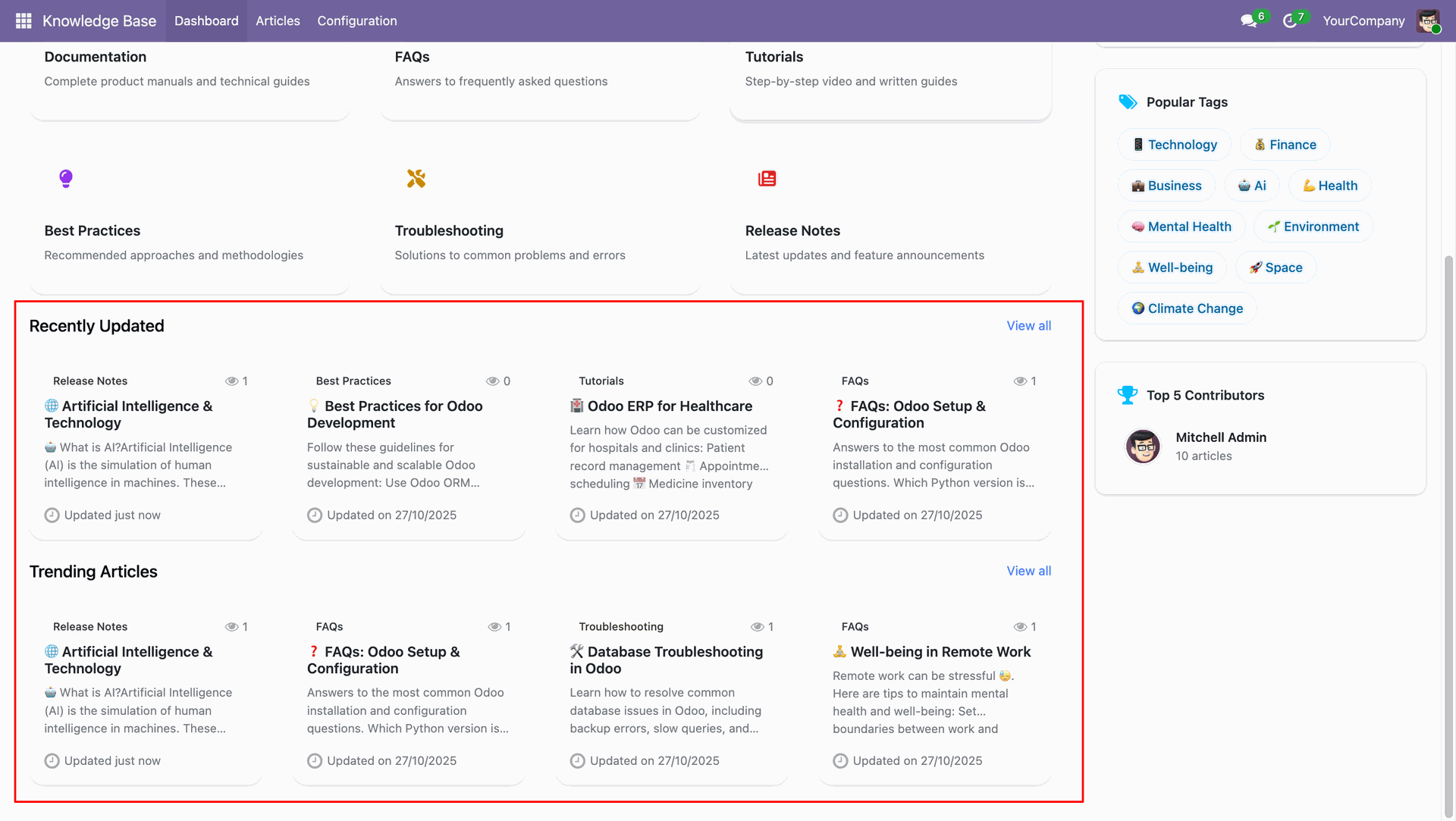
This section shows the Search Functionality of the Knowledge Base.
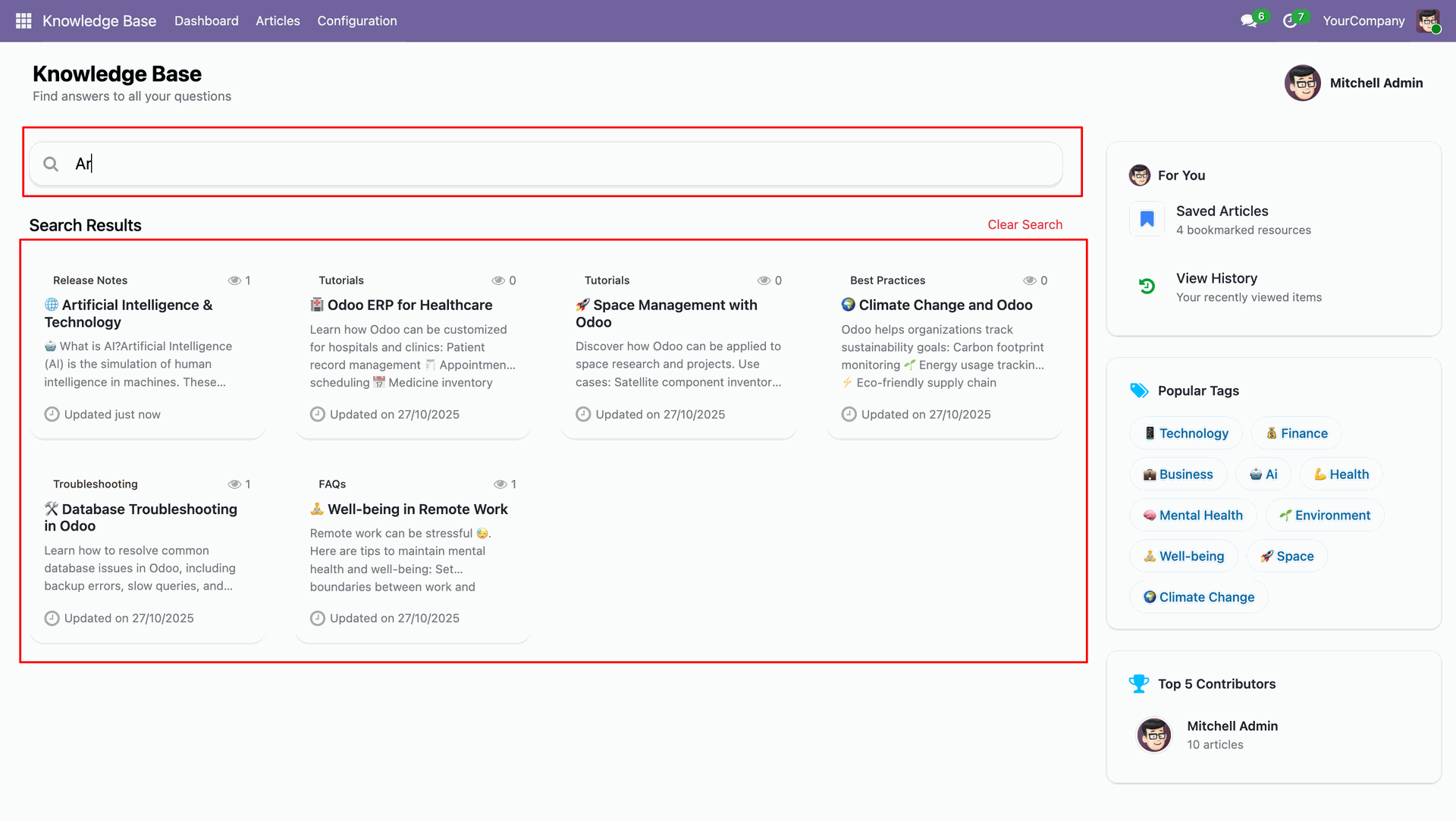
This section highlights the User Panel on the Knowledge Base dashboard. It includes quick access to Saved Articles for bookmarked content and View History for recently viewed items. Below, the Popular Tags area helps users explore trending topics easily, while the Top 5 Contributors section showcases leading content creators based on article contributions.

The customer portal displays a Knowledge Base section showing the total number of published articles. Users can access these articles directly from their account dashboard for quick reference.
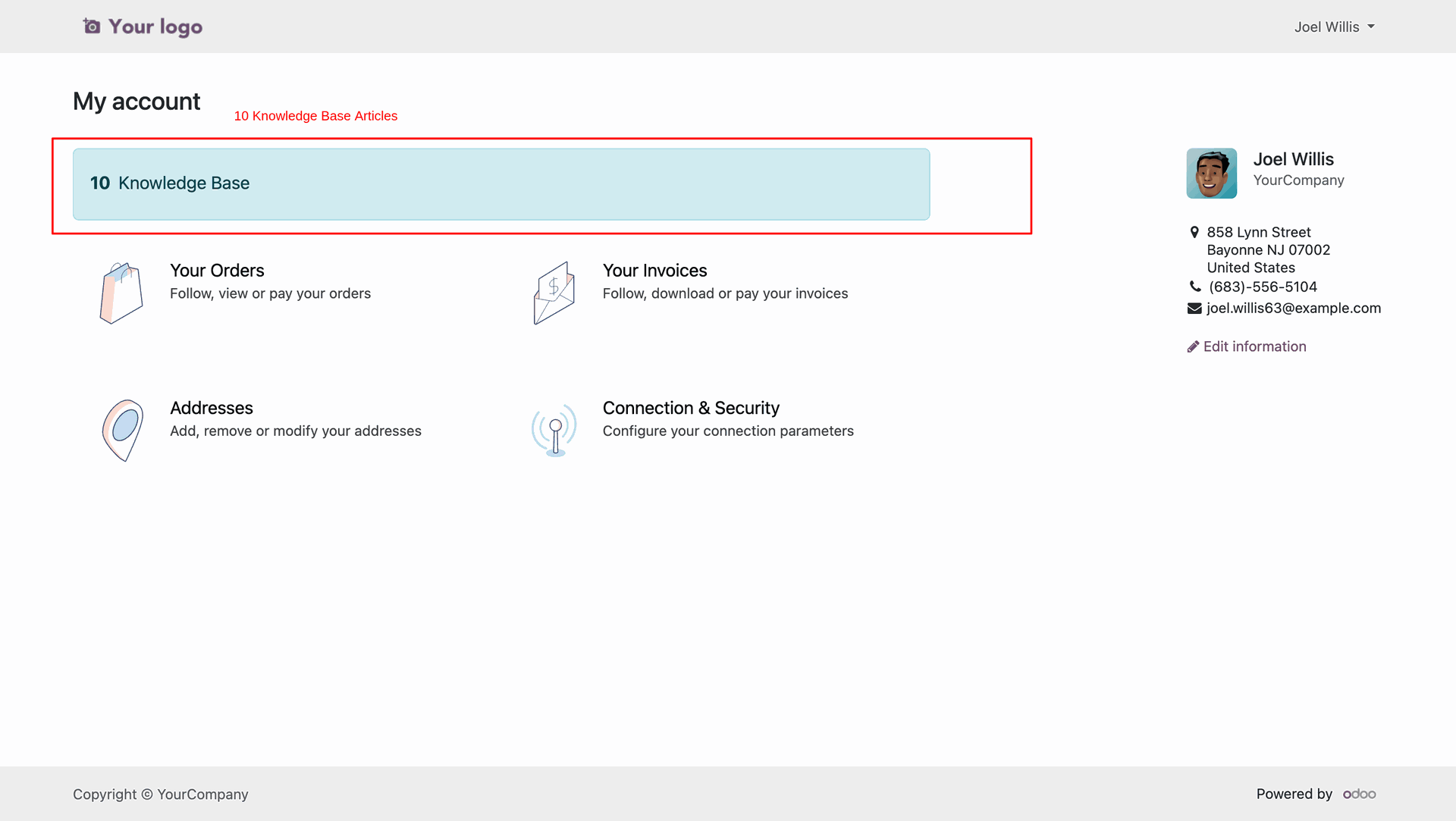
The customer can view all published Knowledge Base articles in a structured list, categorized by type with search and pagination options for easier navigation.

The Knowledge Base articles can also be viewed in a kanban layout, displaying article previews with category labels, short descriptions, and update details for quick browsing.
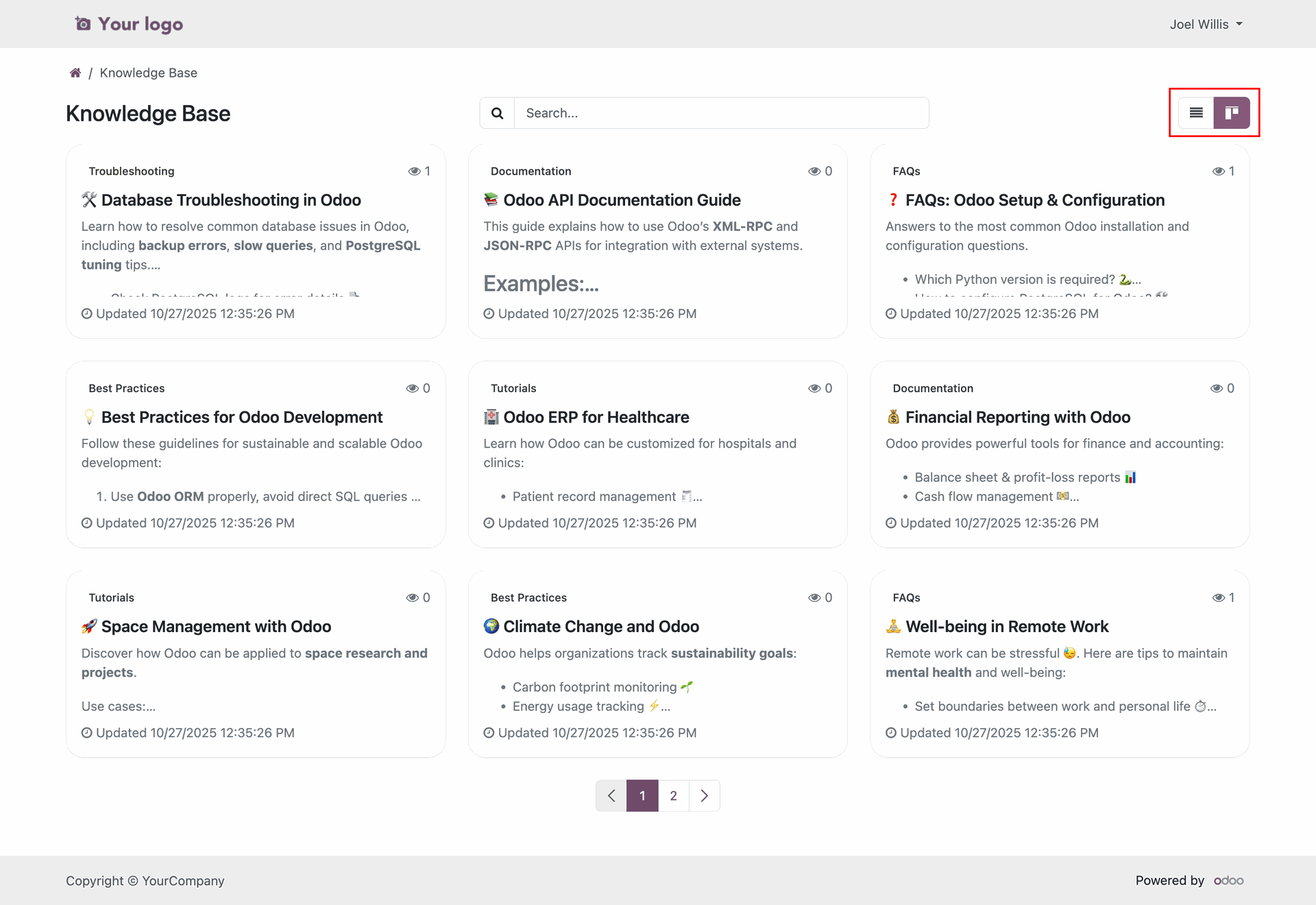
The Knowledge Base includes a smart search feature that allows users to find articles by title, content, category, tags, or author, making it easier to locate specific information quickly.

The system allows users to filter articles by category, displaying only those that match the selected criteria for a more focused search experience.
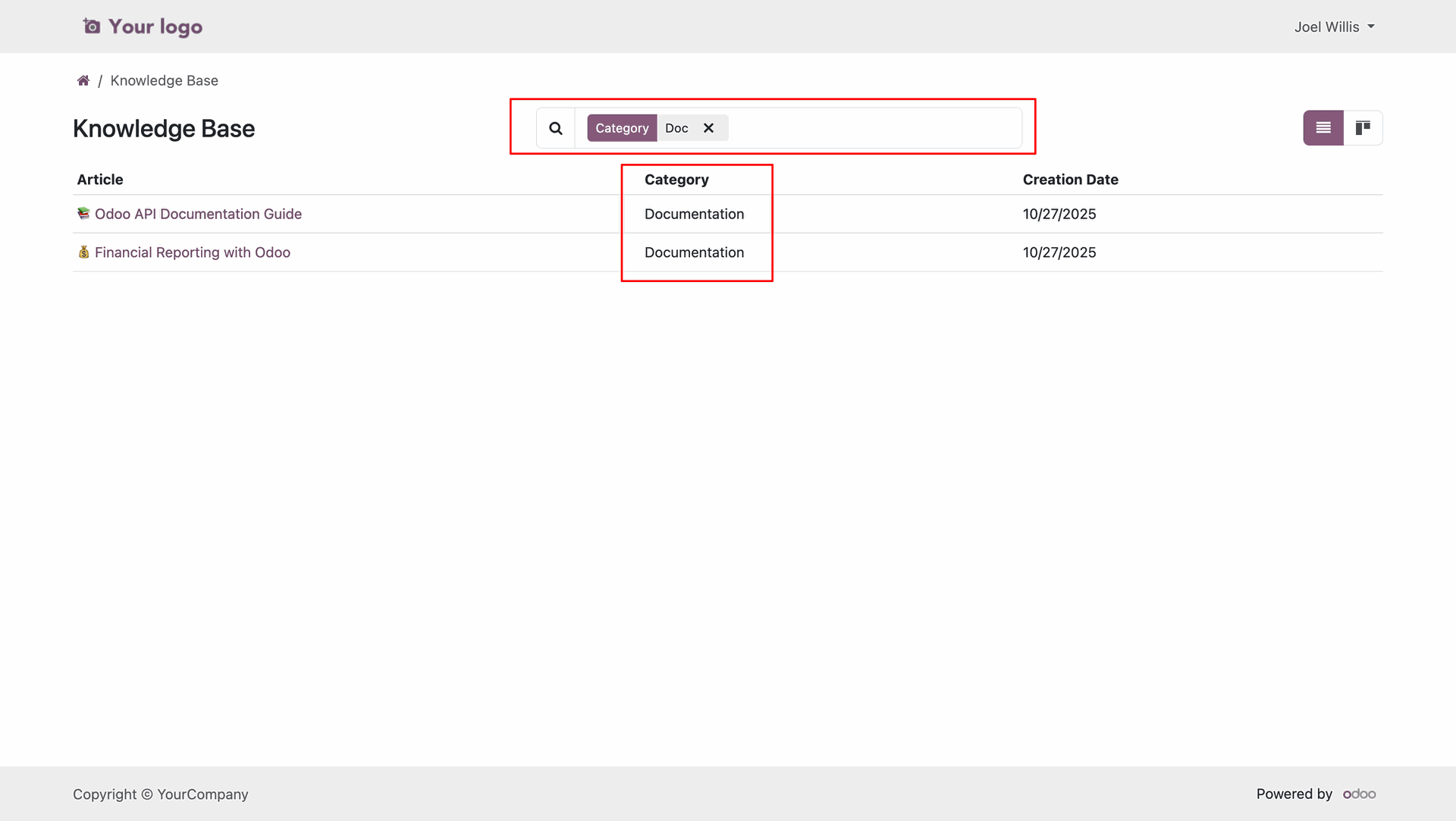
The article view displays a structured layout with a table of contents for quick navigation, categorized tags for better context, and clearly divided sections.
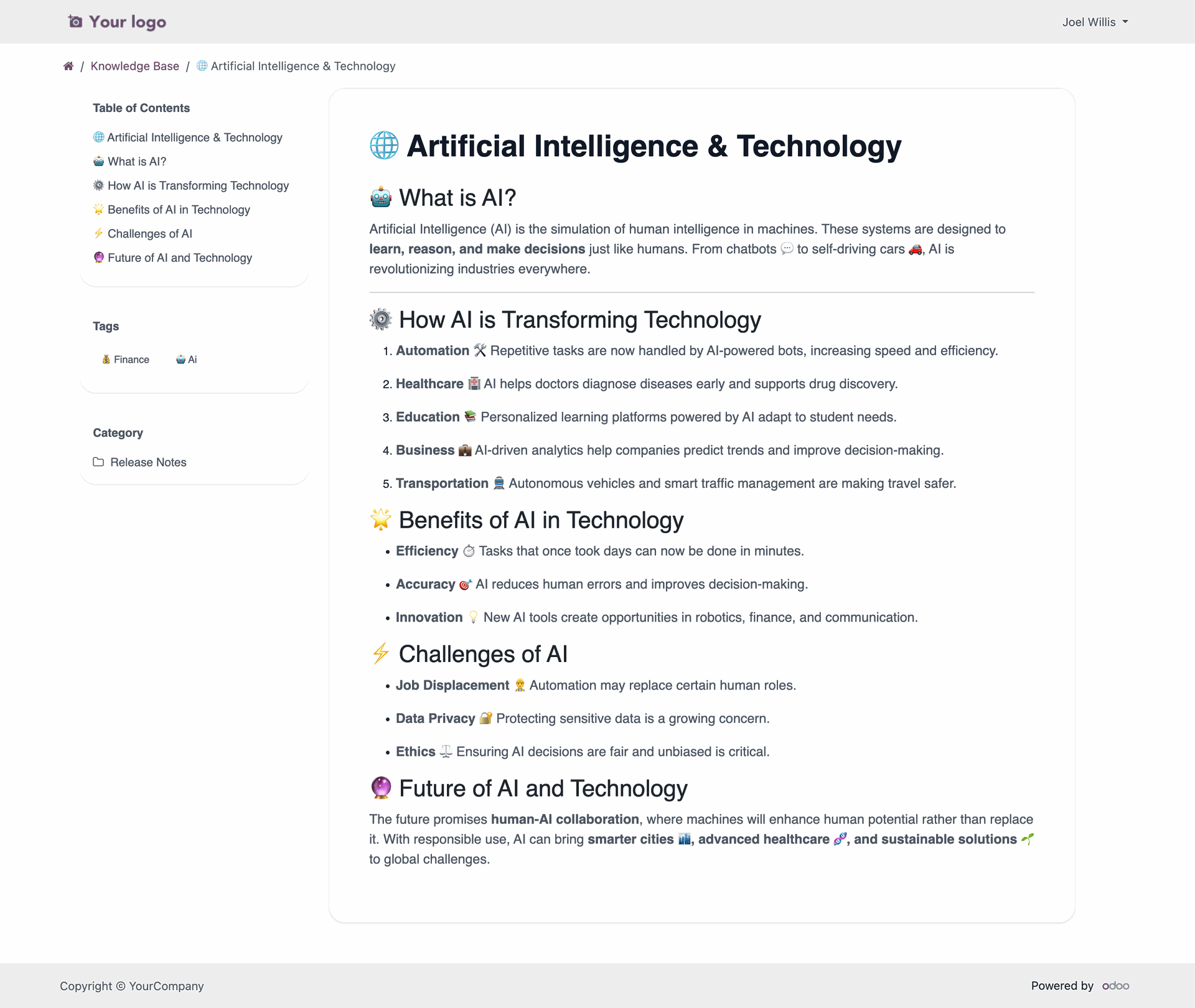
Version 19.0.1 | Released on : 06th November 2025
- Yes, this app works perfectly with Odoo Enterprise (Odoo.sh & Premise) as well as Community.
- No, this application is not compatible with odoo.com(odoo saas/Odoo Online)
- Yes, to test this module, please contact us at sales@softhealer.com.
- Please contact us at sales@softhealer.comto request customization.
- Yes, we provide free support for 365 days from the date of purchase.
- Yes, you will receive lifetime free updates for the version of the module you purchased.
- No, there is no need to install any additional libraries.
- Yes, for version 12 and above, you need to purchase the module separately for each version you intend to use.
- No, exchanges or refunds are not allowed. Please make sure to select the correct version before purchasing.
- You can contact us at support@softhealer.com for language translation support. We use Google Translator tools to provide translations in multiple languages, so the accuracy may vary. We welcome your suggestions to help improve translations.




